
 Jeff Sundin October 21, 2023 "A Beautiful Day - Don't let It Get You Down!"
Jeff Sundin October 21, 2023 "A Beautiful Day - Don't let It Get You Down!"
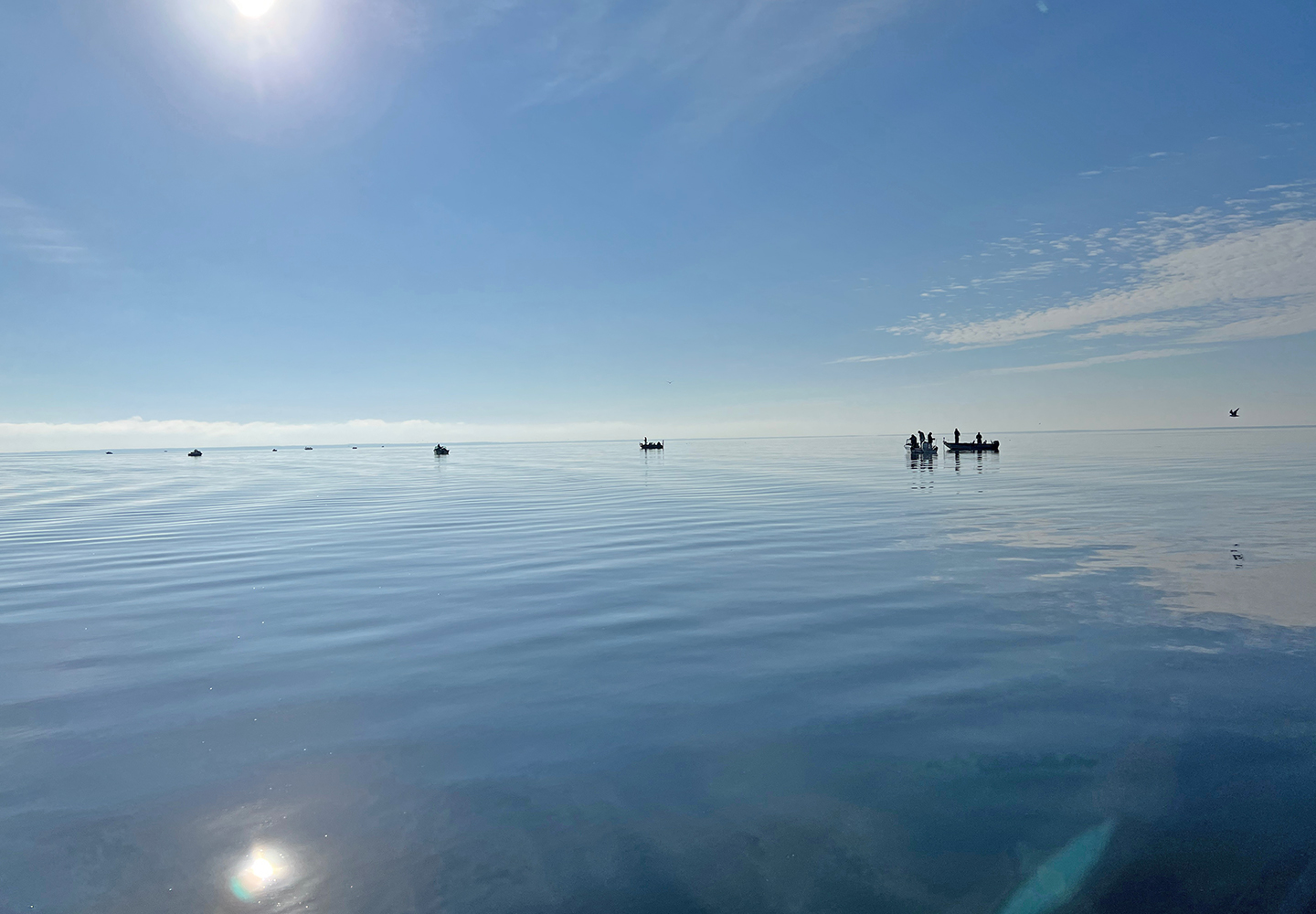 When I pulled into William’s Narrows Resort to pick up Tom Cashman and his buddy Brad on Friday morning, I posed a hypothetical question. “Has it ever happened that you see a boat motoring across the lake and the instant you see it, your little voice says something like, shoot, that guy is headed right for my spot?
When I pulled into William’s Narrows Resort to pick up Tom Cashman and his buddy Brad on Friday morning, I posed a hypothetical question. “Has it ever happened that you see a boat motoring across the lake and the instant you see it, your little voice says something like, shoot, that guy is headed right for my spot?
"Maybe not to you guys, I said, but it happens to me all the time, my wiring might just be weird that way. When I saw the unusually heavy boat traffic heading west through Grand Rapids on Thursday, my little voice said, “I’ll bet they’re all heading for Winnie for the MEA weekend”. It will be interesting to see how wrong I am, I’m sure some of them must have been headed for Cass, or Leech, or maybe toward the Rainy River, they can’t all be on Winnie, can they?"
Well, my little voice was likely more right, then wrong; they may not have all been on Winnie, but a lot of them were. And in one sense, they were in the ideal place, the weather was warm, sunny, and calm, it truly was a beautiful day.
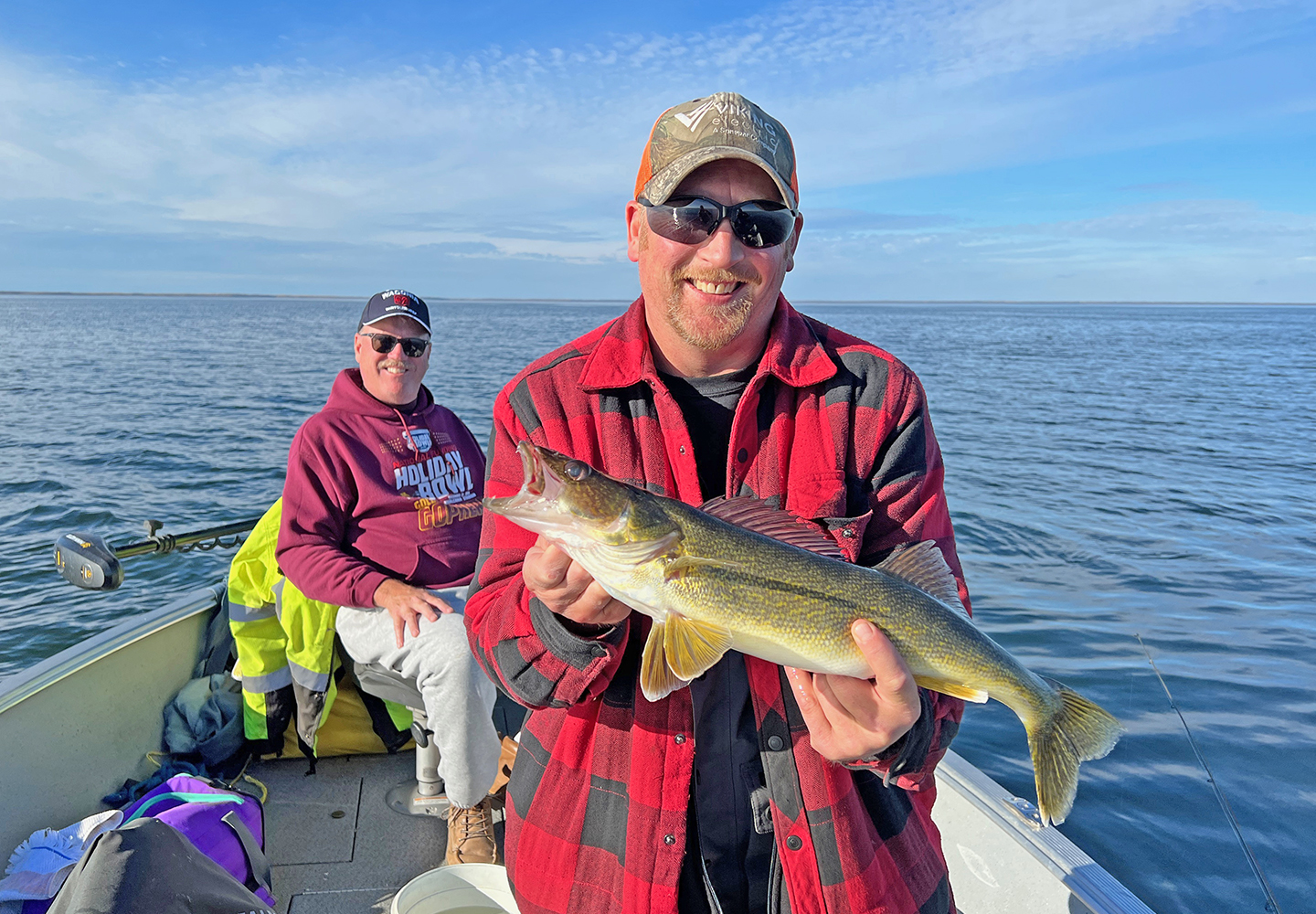 The weather might have been ideal for fishing though, the calm and sunny conditions did serve to slow down the action. Even though I did manage to deliver Tom and Brad back to the dock with their walleye limits, it took several moves, and significant determination to make it happen. We found ourselves starting and stopping a lot, every move we made yielded a burst of action, followed by a predictable slowdown.
The weather might have been ideal for fishing though, the calm and sunny conditions did serve to slow down the action. Even though I did manage to deliver Tom and Brad back to the dock with their walleye limits, it took several moves, and significant determination to make it happen. We found ourselves starting and stopping a lot, every move we made yielded a burst of action, followed by a predictable slowdown.
At the day’s end, I ran into a couple of anglers back at the resort whose stories supported the notion that my experience wasn’t much different from theirs. The folks who struggled were the ones who sat tight on spots that have become popular over the past couple of weeks. The folks who had “good days” were those who have more experience on the lake and tried a wider variety of locations. Like one friend said, “fishing was good, it was just different.”
Experiencing slower than usual fishing action on a calm sunny day is not unusual at all, and I don’t think the quality of “the bite” can be measured by yesterday’s action. In fact, I think the stage could be set for a few more good days. Water temperatures, for one thing, got warmer yesterday. By the end of our trip, 55 degrees was the average reading on my graph.
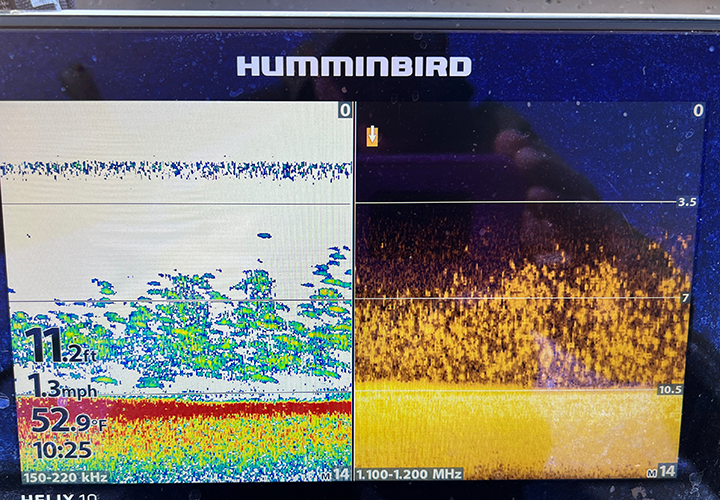 Baitfish balls are still spread along the shoreline breaks and they are piled up higher than my stack of monthly bills. I think it’s going to take a major weather event to force walleyes into moving away from all that available food. Another indicator that points to a few more days of quality fishing is that most folks caught at least some fish yesterday. In my opinion, whenever average anglers catch anything on days like yesterday, it is a sure sign that the fish are still in feeding mode.
Baitfish balls are still spread along the shoreline breaks and they are piled up higher than my stack of monthly bills. I think it’s going to take a major weather event to force walleyes into moving away from all that available food. Another indicator that points to a few more days of quality fishing is that most folks caught at least some fish yesterday. In my opinion, whenever average anglers catch anything on days like yesterday, it is a sure sign that the fish are still in feeding mode.
We’ll have a chance to find out if I’m right today because the weather is going to take a turn. The forecast, gusty northwest winds and mostly cloudy skies should induce more fish movement. Some of the better fishing areas, especially those located along the north shore like Pidgeon River, Stony Point, Third River, and Mallard Point will be wavy, but good.
There are so many recent reports about depth and presentations that I don’t think we need to go into much detail. Key depths for walleyes are still 10 to 14 feet of water on the shoreline breaks. Perch are located shallower, 4 to 7 feet of water is more productive for them, but you’ll have to be in the wind for that to work; perch have been moving in when the waves do, and moving out when it’s calm.
J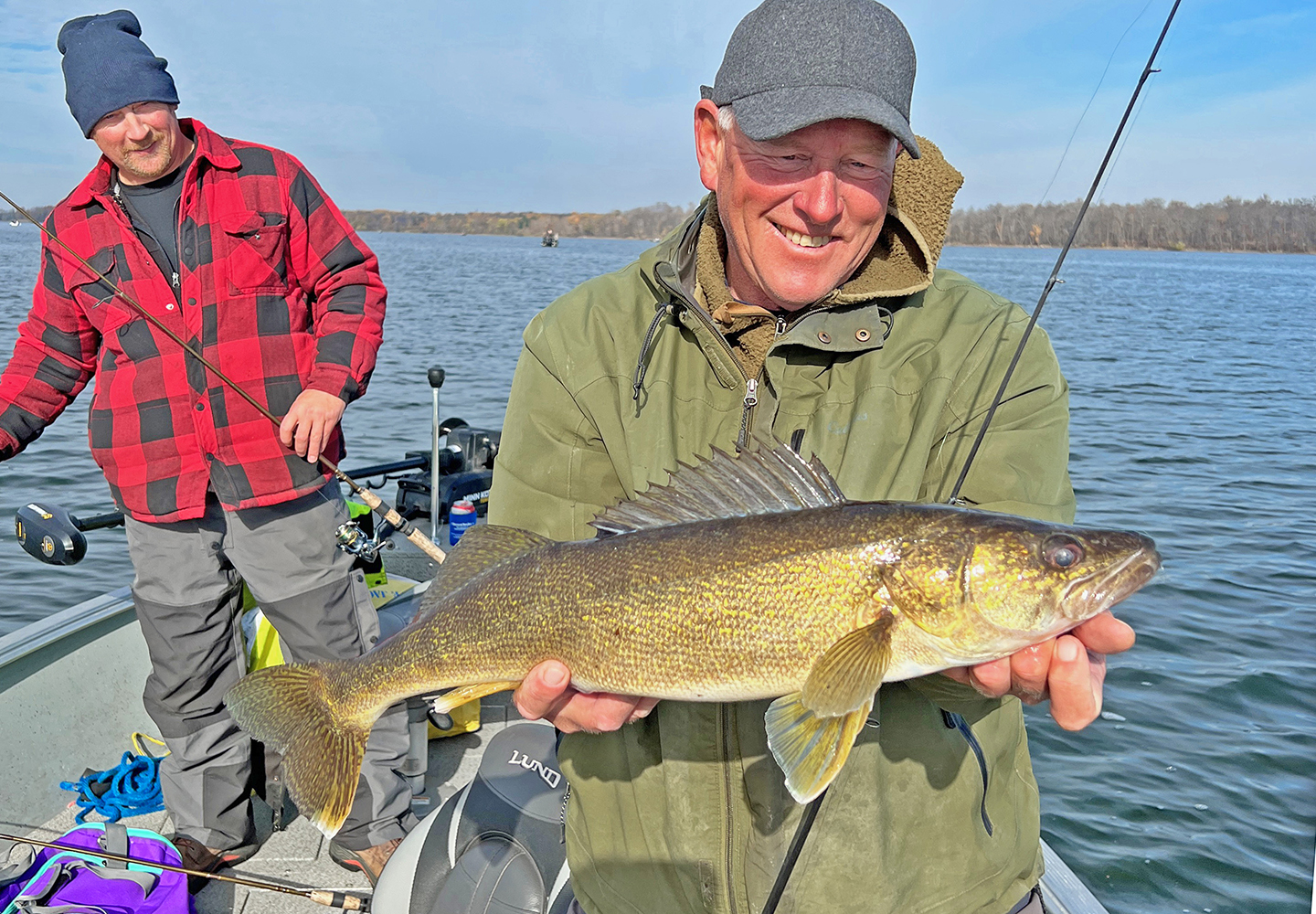 igs and minnows are plenty reliable, and if you can get them, larger minnows, 3 to 4 inches long, work better than smaller minnows. We had fatheads, rainbows and some river mix minnows yesterday, all of them worked. Jig colors for me have seemed to revolve around the glow varieties. Glow-Pink has been my recent favorite, Glow-Perch and Glow-Blue are good too. For me, there is no other jig than the Lindy Live Bait Jig, and 1/8 ounce is the standard size we’ve been using. For perch in the shallows, we switch to 1/16 ounce and when we move out deeper than 14 feet, we switch to ¼ ounce jigs.
igs and minnows are plenty reliable, and if you can get them, larger minnows, 3 to 4 inches long, work better than smaller minnows. We had fatheads, rainbows and some river mix minnows yesterday, all of them worked. Jig colors for me have seemed to revolve around the glow varieties. Glow-Pink has been my recent favorite, Glow-Perch and Glow-Blue are good too. For me, there is no other jig than the Lindy Live Bait Jig, and 1/8 ounce is the standard size we’ve been using. For perch in the shallows, we switch to 1/16 ounce and when we move out deeper than 14 feet, we switch to ¼ ounce jigs.
Cutfoot Sioux is usually a good, safe bet for catching walleyes during the fall, but this year is a little different. Those massive schools of baitfish on the big lake are holding a lot of fish back from migrating into Cutfoot, I think. That said, we have been picking up some walleyes on come of Cutfoot’s more popular spots. So, if it’s too windy for you on the big lake, it is an option.
If there is any reliable crappie fishing spot on Cutfoot, I haven’t found it. I have not searched everywhere, but I have checked out many of the most popular places and caught very few fish. There are some perch biting in Cutfoot’s shallows though, and that might be a better way to keep busy, especially if your kids are with you this weekend. Another good “kid thing” to do on Cutfoot is to creep along the weed edges using a jig tipped with ½ of a night crawler. A few days back, we slow trolled at about 7 feet deep, holding close to the weeds, and caught northern pike, sunfish, rock bass and even a largemouth bass. It wouldn’t surprise me if there were a few crappies and walleyes there too, but we didn’t fish that way long enough to learn that.
If you’re in the area, but not headed for the big water, you should be able to find active panfish on many of the area’s small lakes. Reports from friends are generally good, and in many cases, panfish have begun showing up in classic, mid-lake basin areas. Check out the recent crappie reports for information that might help, should you decide to go that route.
My game plan for today is unclear, knowing my crew, I don’t see fishing in big waves as an option. So, I’ll be winging it to see whatever I can come up with and that, whatever it is, will be the subject of another report. Good luck out there, and please do share a note about how your day goes. ![]() — Jeff Sundin 218-245-9858 or EMAIL
— Jeff Sundin 218-245-9858 or EMAIL
More Recent Fishing Reports
L.O.W 10-25 • Sundin 10-24 • Grand Rapids 10-23 • Sundin 10-22 • Sundin 10-21 • Winnibigoshish 10-20 • Crappie Report 10-18 • Lake Winnie 10-17 • L.O.W 10-17 • Crappies 10-16 • Winnie Walleyes 10-14 • Crappies 10-13 • Winnie 10-12 • Winnie Weeds 9-26 • Forward Sonar • Panfish Workgroup • Follow on Facebook
 Wired2Fish October 20, 2023 "How to Fish Big Swimbaits for Fall Bass"
Wired2Fish October 20, 2023 "How to Fish Big Swimbaits for Fall Bass"
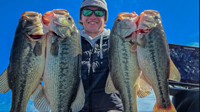 "Fall is a great time to get on the water and enjoy all nature has to offer. Not only can you experience the beautiful scenery and changing colors, but the fishing can also be quite productive this time of year. This is especially true when throwing big shad imitation baits. Throughout the fall fish quickly begin to target shad, bluegill and other baitfish in order to feed up before the cold winter months. This is the perfect time to throw big swimbaits for fall bass on your local body of water.
"Fall is a great time to get on the water and enjoy all nature has to offer. Not only can you experience the beautiful scenery and changing colors, but the fishing can also be quite productive this time of year. This is especially true when throwing big shad imitation baits. Throughout the fall fish quickly begin to target shad, bluegill and other baitfish in order to feed up before the cold winter months. This is the perfect time to throw big swimbaits for fall bass on your local body of water.
While many anglers are intimidated by the size of these baits, you’d be surprised how many fish are willing to eat such a large lure. Throwing these type of baits, though, requires confidence. Once you understand what, when and where to throw these big lures, this style of fishing can becomes fairly simple.
Big swimbaits produce big bass because they ..." Learn More >> How to Fish Big Swimbaits for Fall Bass
 Cutfoot Sioux, Lake Winnie Fishing Report October 20, 2023
Cutfoot Sioux, Lake Winnie Fishing Report October 20, 2023
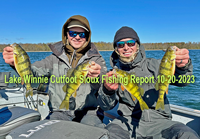 "Surface water temperatures remain stable. The lake water temperature dropped into the low 50s during the last cold snap, they settled in at about 53 degrees, and have remained there for over a week. On Thursday, the water temp measured not far from the resort was 53.5 degrees. Stability is one key to great fishing, and we think this helps explain why walleye anglers have enjoyed such great success this fall.
"Surface water temperatures remain stable. The lake water temperature dropped into the low 50s during the last cold snap, they settled in at about 53 degrees, and have remained there for over a week. On Thursday, the water temp measured not far from the resort was 53.5 degrees. Stability is one key to great fishing, and we think this helps explain why walleye anglers have enjoyed such great success this fall.
The fall feeding migration is helping too. As Lake Winnie’s large 2018- and 2019-year classes move toward shoreline breaks, they encounter huge clouds of baitfish, primarily young perch that hatched earlier this season. With the massive supply of food, walleyes have been feeding relentlessly, and have achieved ideal size. Folks are reporting catching good numbers of fish in the ..." Read Full Winnie Fishing Report October 20, 2023
 Jeff Sundin October 17, 2023 "Lake Winnie Walleye Report"
Jeff Sundin October 17, 2023 "Lake Winnie Walleye Report"
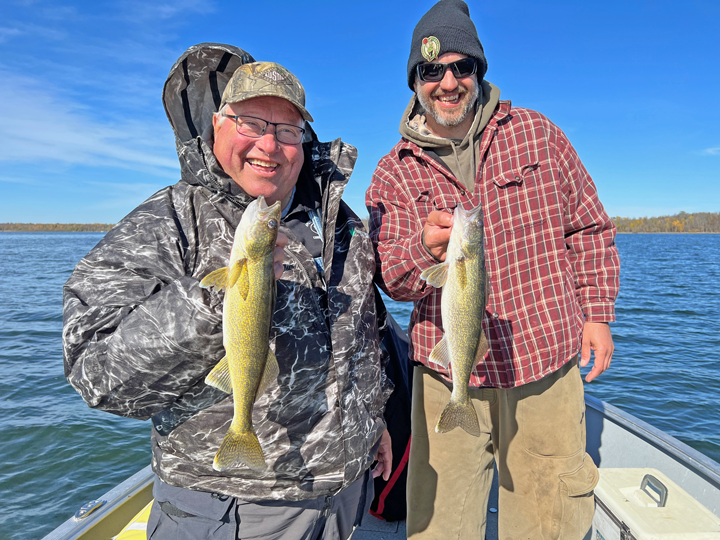 At a time when most resorts are either already closed, or preparing to close, you’d expect to read that fishing traffic on Winnie has faded to black. Actually, that’s sort of what I expected to be writing this morning, but I found out yesterday that I, a couple dozen fellow anglers, and Mother Nature have something in common right now; none of us is ready to give up on fishing Winnie just yet.
At a time when most resorts are either already closed, or preparing to close, you’d expect to read that fishing traffic on Winnie has faded to black. Actually, that’s sort of what I expected to be writing this morning, but I found out yesterday that I, a couple dozen fellow anglers, and Mother Nature have something in common right now; none of us is ready to give up on fishing Winnie just yet.
On Monday, the air temperature at my house was 29 degrees when I rolled down the driveway. When I met up with my crew, Matt, and Bill, at William’s Narrows Resort on Cutfoot, my first words were cautious. “Well boys, I’ve got my fingers crossed that the water temperature held up since my last trip here on Friday. The walleyes were biting then, and I got good reports from friends over the weekend, all we need is for the fish to stay where they were and keep on biting. Every day though, I show up expecting that this might be “The Day” when the temperatures plummet and the daytime walleye bite crashes; let’s just hope that it’s not today.”
Luckily for us, yesterday was not “The Day”. Surface water temperatures held at about 53 degrees in shallow water, and as the image of my graph reveals, almost 55 degrees in deeper water over the middle of the lake. I was a bit surprised that the temps held that steady after the frosty night we experienced. I guess this is the natural point of resistance and will hold until the lake water finally loses its warmth. Sunshine, calm water and warm air temperatures on Monday will likely help the lake hold on to a bit of heat too and that could bode well for the next few days.
The fishing report is much like what I’ve written in the past week or so. I didn’t make any new discoveries about fish locations or come up with any hot new presentations. We just went back to the same regions of the lake where we caught fish last week, fished the same way, and caught the same fish. The walleye action was not fast and furious, but it was steady, and by about 1:00 PM, we had enough walleyes to send the crew home with limits.
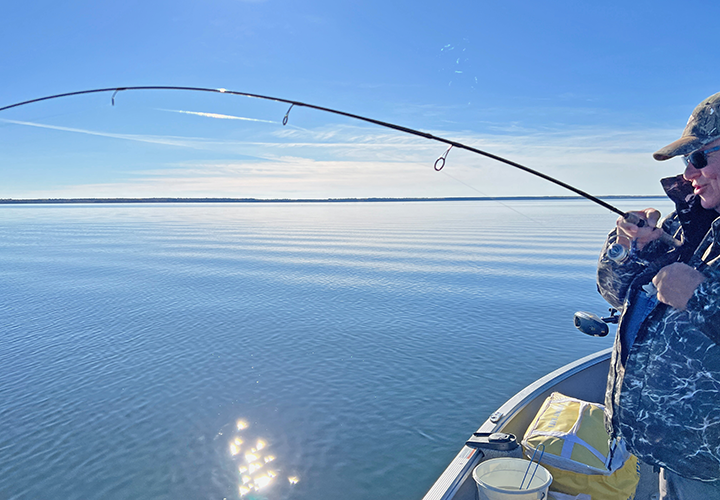 Our key depth was 12 feet of water, and we fished with Lindy Live Bait Jigs tipped with minnows. There is no wind for drifting, so I back trolled with the electric motor at .5 MPH. Sounds a lot like a finesse bite huh, the sort of time when walleyes are finicky, and it takes a genius to coax them onto the hook. But at the same time, we fished there, a text from a friend came over the wire. It said, “There’s a lot of baitfish in 14 feet of water, along with lots of yellow and heavy red marks among them. I picked up a dozen in 1-1/2 hours trolling cranks.” Hmm, fishing on the same lake, at the same time, and there are 2 complete opposite presentations, both working well; that’s something to think about.
Our key depth was 12 feet of water, and we fished with Lindy Live Bait Jigs tipped with minnows. There is no wind for drifting, so I back trolled with the electric motor at .5 MPH. Sounds a lot like a finesse bite huh, the sort of time when walleyes are finicky, and it takes a genius to coax them onto the hook. But at the same time, we fished there, a text from a friend came over the wire. It said, “There’s a lot of baitfish in 14 feet of water, along with lots of yellow and heavy red marks among them. I picked up a dozen in 1-1/2 hours trolling cranks.” Hmm, fishing on the same lake, at the same time, and there are 2 complete opposite presentations, both working well; that’s something to think about.
With plenty of walleyes in the larder, it was time to try something else. I was skeptical that the perch we’d caught last week had followed suit and were still in the same spots. Finding them in those shallow spots, with bright sun and no wind, would be a stretch. I had to at least try though so, we returned to one of the shallow water spots where we caught them last week.
It turned out that I was right to be skeptical, the shallow water was clear, we could see everywhere around the boat and except for one pack of little fish, the perch we sought had fled that scene. I burned up a little more time searching for them in deeper water, but my patience ran out before the perch turned up, and our attention turned back to walleye fishing.
“Well boys, if the fish were still located on the north side, maybe the ones we found down south are still there too,” I said. We motored south to check it out and when we stopped the boat, there were fish on the screen. The effects of the sunshine were more evident in the afternoon. The water depth of our first pass was about 15 feet of water, and the action was decent, especially for “Lake of the Woods Bill”, who caught and released the lion’s share. So, I circled back for a 2nd try. But when I started that pass, the fish had already moved deeper, signaling me that they were “boat shy”. Now the fish were almost 20 feet deep and while we caught a few of them, the rest had lock jaw.
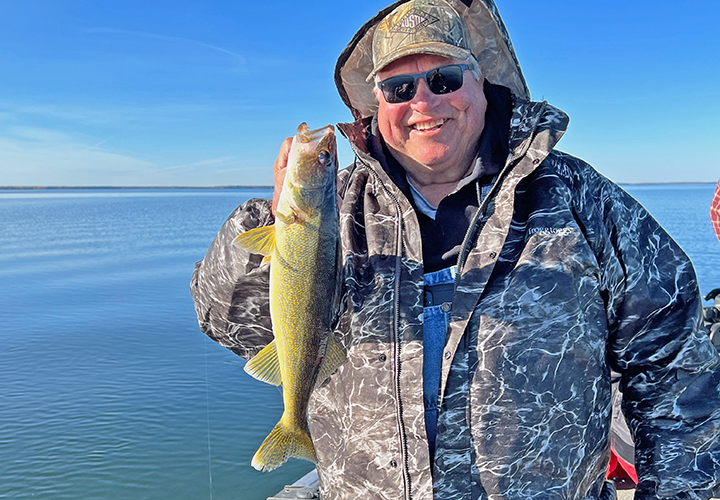 By now, it was after 4:00 PM anyway, so we called it a day and headed back to the dock. On the trip home, I re-ran my take-away thoughts about our day, the first of which was thankfulness about our good fortune. After that, my mind got stuck the facts; the sun was bright, the water was clear, the wind was calm, and despite all that, the fish bit. Hmm, how is it that with the odds stacked against us, we still had such a good day?
By now, it was after 4:00 PM anyway, so we called it a day and headed back to the dock. On the trip home, I re-ran my take-away thoughts about our day, the first of which was thankfulness about our good fortune. After that, my mind got stuck the facts; the sun was bright, the water was clear, the wind was calm, and despite all that, the fish bit. Hmm, how is it that with the odds stacked against us, we still had such a good day?
This is a subject I’ve covered before, so I won’t re-write the whole story. But every fall, there is a day when I feel like I was born with a golden horseshoe, a day when I can do nothing wrong, (I mean in terms of catching walleyes). Then, just when I think I’ve got everything figured out, my next trip is a flop. It’s hard to say if yesterday was that day or not, but like I said last Saturday, I know my days are numbered.
The point will be moot soon, as October 25th is may last date on the calendar. After that, I’ll join the ranks of everybody else who has already closed for the season. Yesterday I learned that Highbanks closed down after last weekend, Williams Narrows, still open, will close soon too, in fact Bobbers Bar closes today. It won’t be long before fish cleaning stations will be locked up, docks will be pulled out from the landings and all the portable toilets will be gone; most are already gone.
Today, Matt and Bill are back, but we don’t need walleyes. Crappies are on the agenda, maybe sunfish too and possibly a northern pike, or perch if I can find some. I’ll let you know how it goes tomorrow. ![]() — Jeff Sundin 218-245-9858 or EMAIL
— Jeff Sundin 218-245-9858 or EMAIL
 Wired2Fish October 17, 2023 "When to Change Your Fishing Line"
Wired2Fish October 17, 2023 "When to Change Your Fishing Line"
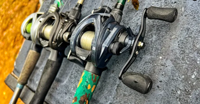 "When should you change your fishing line? As an angler, it’s important to figure out when to change your fishing line. If you don’t change it soon enough, your line could fail in a critical fight with a big fish or while bomb casting a high-dollar lure. If you get in the habit of changing it too early, however, you could cost yourself hundreds if not thousands of extra unnecessary dollars over time.
"When should you change your fishing line? As an angler, it’s important to figure out when to change your fishing line. If you don’t change it soon enough, your line could fail in a critical fight with a big fish or while bomb casting a high-dollar lure. If you get in the habit of changing it too early, however, you could cost yourself hundreds if not thousands of extra unnecessary dollars over time.
There’s an art to knowing when to change your line— and a bit of an art to the actual process of changing out old line for new. You can find some pointers here on how to spool line on a fishing reel. As for knowing when to do this, it depends based on the type of line.
There are three main types of ..." Learn More >> When to Change Your Fishing Line
 Jeff Sundin October 14, 2023 "Lake Winnie Hanging In At 53!"
Jeff Sundin October 14, 2023 "Lake Winnie Hanging In At 53!"
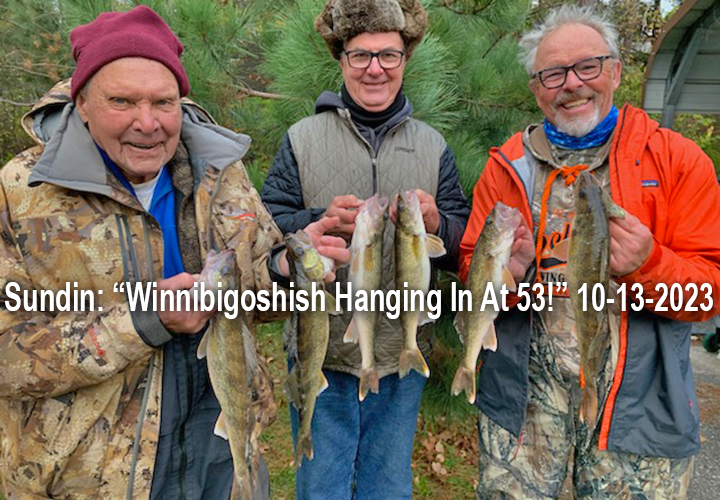 Okay, it’s Saturday morning and typically for me, the one day each week that I don’t write a fresh report. Today though, I think the timing is important because I’ve been seeing an above average number of boats fishing on Winnibigoshish. So, I’m offering a “special update” for anybody who’s already there or headed there this weekend.
Okay, it’s Saturday morning and typically for me, the one day each week that I don’t write a fresh report. Today though, I think the timing is important because I’ve been seeing an above average number of boats fishing on Winnibigoshish. So, I’m offering a “special update” for anybody who’s already there or headed there this weekend.
Whenever the surface water temperatures drop below 55 degrees, I start getting concerned that the “easy days” on the lake are numbered. No matter how good the walleyes bite one day, I know that soon, the fall feeding frenzy will end, seemingly faster than it started. So, staring at the number 53 at the upper left corner of my graph had me sitting on the edge of my seat on Friday. I hoped that the walleye bite was still going, and also hoped those locations hadn’t changed much since my last full day walleye charter there last Tuesday.
With a stiff northeast wind, some of my preferred fishing spots were temporarily off limits. The south and west shorelines, along with any of the mid-lake bars would simply be too rough for my crew. So, I started the trip on the north shore, in the company of another half dozen other boats. The breakline from 12 to feet of water held fish, but they were not hot to trot; I caught 2, but except for 1 small pike, Carl, Curt and Jay came up blank. That first stop made me nervous, but I figured if we could get 2 fish there, we could at least get a few more fish if we worked at it.
My 2nd stop worked out better. When I rounded the corner at Stony Point and headed north toward Third River, fishing conditions were ideal. The grey skies and strong easterly wind provided us with a perfect controlled drift speed of .5 MPH. The water temperature there was slightly warmer, 53.6 degrees, still troubling, but my worries would be short-lived. Within 10 to 15 minutes, I swerved into the right run, and we began catching walleyes. I won’t call it a “hot bite” but I will say that the action was steady. From about 11:00 AM to around 3:00 PM, we never left that area, and when we did, the crew were in possession of their legal limits.
 The key depth range was 11 to 13 feet of water, 12 feet was my ‘sweet spot”. That said, there were a dozen other boats in that region too and they all seemed to have their own “sweet spots”, very few of them ever moved very far from where they were fishing when we first saw them. I think I know why, there are clouds of baitfish everywhere in the flowage; any fish that wants to eat, can eat, and easily. With all that food in the area, anglers had extra latitude, the structure did not seem to be as important as it often is. Some fish were loosely related to the shoreline break, and some were roaming the gravel flat. It helped too that fishing conditions were ideal, I could not have asked for a more perfect drift, better lighting or a nicer “walleye chop”.
The key depth range was 11 to 13 feet of water, 12 feet was my ‘sweet spot”. That said, there were a dozen other boats in that region too and they all seemed to have their own “sweet spots”, very few of them ever moved very far from where they were fishing when we first saw them. I think I know why, there are clouds of baitfish everywhere in the flowage; any fish that wants to eat, can eat, and easily. With all that food in the area, anglers had extra latitude, the structure did not seem to be as important as it often is. Some fish were loosely related to the shoreline break, and some were roaming the gravel flat. It helped too that fishing conditions were ideal, I could not have asked for a more perfect drift, better lighting or a nicer “walleye chop”.
We used 1/8-ounce Lindy Live Bait Jigs tipped with minnows. I have my own person favorite minnows, but I do think that any of the popular minnow varieties will work if the size is right. Larger fatheads, rainbows, and river mix minnows in the 3-1/2-to-4-inch range are ideal. It took us a while to get good at setting the hook. When the fish struck, we needed to give them plenty of time to work their way up the minnow, and onto the hook.
The segregation of fish species is notable, during our trip, we never caught a perch and only 2 scrawny northern pike. The only perch and pike spots I knew about are in shallower water and apparently the fish are keeping it that way, at least for now. Hopefully, I’ll be able to expand on that in the upcoming days, upcoming days by the way, that are numbered.
At 53, Winnie is hanging in there and walleyes remain active, at least they did yesterday. I’d like to believe that current conditions will last scheduled trip of this season on October 25th, but realistically, don’t expect that to happen. Soon, the water will get cold enough, or the fishing conditions will change, or whatever it is that happens will happen and the fall bite will temporarily be over.
I’ll keep you updated about Winnie every chance I get, but unfortunately that won’t be today. My problem, if you want to call it that, is that I have Carl, Jay, and Curt again today and they already have their limits of walleyes. So, instead of heading for Winnie, we’ll be wandering around on a smaller lake searching for panfish instead.
If you’re out there today and would be willing to help your fellow anglers, then please do. There’s plenty of room on the staff for another Cub Reporter and you know what they say, “what goes around comes around.” It is just a matter of time before something they offer winds up helping you too. ![]() — Jeff Sundin 218-245-9858 or EMAIL
— Jeff Sundin 218-245-9858 or EMAIL
 Jeff Sundin October 12, 2023 "Winnie Walleye-Perch Still Prowling The Shallows"
Jeff Sundin October 12, 2023 "Winnie Walleye-Perch Still Prowling The Shallows"
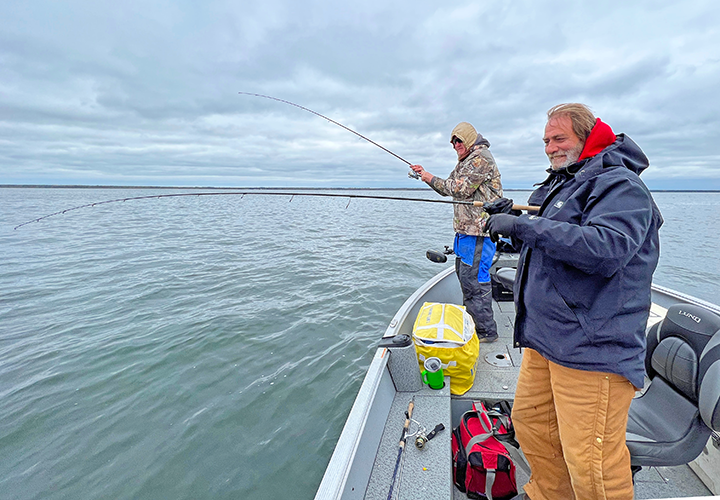 Around the Grand Rapids region, many, maybe most resorts on small lakes are closed for the season. On the larger, more popular fall fishing destinations like Winnie, Cass, Mille Lacs and Leech, some of the resorts are closed for the season, but some are still open and hosting small groups of “die-hard anglers. The clock may be ticking, but for the folks who are on the water, fishing remains good.
Around the Grand Rapids region, many, maybe most resorts on small lakes are closed for the season. On the larger, more popular fall fishing destinations like Winnie, Cass, Mille Lacs and Leech, some of the resorts are closed for the season, but some are still open and hosting small groups of “die-hard anglers. The clock may be ticking, but for the folks who are on the water, fishing remains good.
My time has been split between crappie fishing smaller waters, and walleye-perch fishing on Winnibigoshish. This morning, I’d like to have time for detailed reports about both, but I don’t. My sense is that there are probably more people interested in Winnie than there are focused on crappies, so let’s start there today. Tomorrow, I’ll give you a more thorough crappie fishing report.
The hard frost that struck our region on October 9th took a big bite out of Winnie’s surface water temperatures. Yesterday (10-11-23), they ranged from a low of 53 degrees, up to 55.6 degrees in the areas we fished. These temps make me nervous, but the fish are still happy enough to keep on biting and if they don’t drop much more, we should have one more good weekend of fishing on the big lake.
About a week ago, there was an abrupt change of wind direction. After more than a week of southerly breezes and stable fishing patterns, it switched to the west and blew in with a vengeance. When that happened, my world changed, I had to abandon known locations and find new areas to fish. Yesterday, the wind was calmer, and blew from the east, so we had time to check some of the week-old fishing areas. To my surprise, the fish locations have not changed much since last week’s turbulent weather.
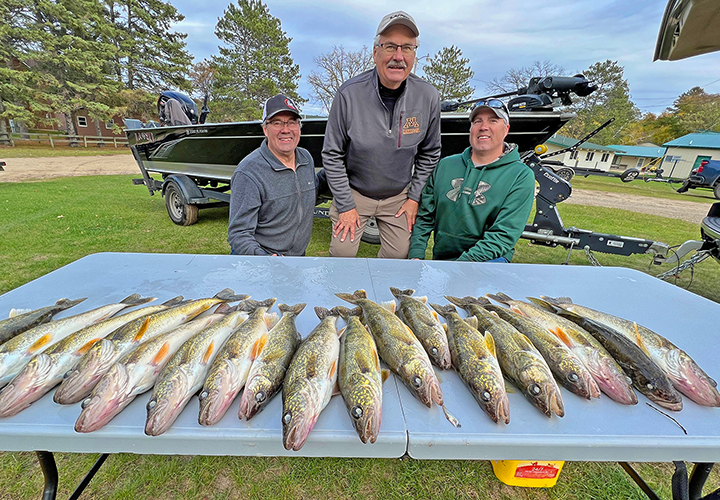 The walleyes on the lake’s largest bars, like Center, Horseshoe, Bena, Zoomers and others, are holding along the breakline edges in water depths of 15 to 25 feet. My crew, “Bugs” Benton and his buddy Dana, didn’t need many walleyes because we’d packed some up already from our trip on Monday. Pictured here with a double hookup, you can understand why we didn’t need to fish very long to catch the 5 fish needed to fill their walleye tags. We used 1/14-ounce Lindy Live Bait Jigs, tipped with minnows, and jigged using a soft “pop-drop-pop-drop” motion. The key depth yesterday was 17 feet, but that will vary daily, sometimes hourly, so check both deeper and shallower water often.
The walleyes on the lake’s largest bars, like Center, Horseshoe, Bena, Zoomers and others, are holding along the breakline edges in water depths of 15 to 25 feet. My crew, “Bugs” Benton and his buddy Dana, didn’t need many walleyes because we’d packed some up already from our trip on Monday. Pictured here with a double hookup, you can understand why we didn’t need to fish very long to catch the 5 fish needed to fill their walleye tags. We used 1/14-ounce Lindy Live Bait Jigs, tipped with minnows, and jigged using a soft “pop-drop-pop-drop” motion. The key depth yesterday was 17 feet, but that will vary daily, sometimes hourly, so check both deeper and shallower water often.
Fishing with the same crew on Monday, and again with the Fischbach clan (pictured right) on Tuesday, our walleyes were caught on the complete other side of the lake, and in shallower water to boot. On those 2 days, the key depth range was between 10 to 14 feet, and we fished shoreline breaks instead of mid-lake structure. Again, the Lindy Live Bait Jigs tipped with minnows were used, but we were able to get away with lighter 1/8-ounce weights.
On the north shore, I used the electric motor to creep along slowly, at about .4 MPH while we cast our lures toward the shallows. I held the boat in 14 feet of water, and I suppose our jigs were landing in water depths of 10 to 11 feet. We jigged using a semi-aggressive, but not fast moving, “hop-drop-hop-drop” motion. The idea is to get the fish’s attention by making the jig hop up and down, but not moving very far with each hop. Ideally, your lure would move a few inches at a time, try to imagine minnows you’ve seen rolling and flickering near the bottom. The flash catches your eye, and if you were a walleye, you’d move closer to investigate, then eat it.
Around the corner, near Stony Point, we fished pretty much the same way, but on Monday, it took more horsepower. There was a stiff wind blowing and we tried drifting in the whitecaps. Even with the drift sock out, our speed was too fast though. At 1.0 to 1.2 MPH, we could get fish to strike, but not hold the bait long enough to accomplish a proper hook set. When I started trolling backward using the outboard, Bugs and Dana began hooking fish, for that to happen, I had to hold my boat speed at .5 to .6 MPH.
Tuesday morning, I high-tailed back up to the same spot and the fish were still there. The first 6 or 7 fish came quickly, but the water was calmer, and became calmer still as we fished. Instead of riding high along the break in 10 feet of water, they slipped out deeper, holding in about 13 feet of water. They were catchable, but the action was slower and with a crew of 3 people, it took most of the day to reach 18 fish. Once we did, I tried to find some perch at a couple of likely spots but did not find them quickly enough.
Perch fishing on Wednesday worked out better because we had all that we needed for a good outcome, more time, more wind, and more clouds. I took a chance on finding perch in the shallows where they were a week ago. It might sound like a tall tail but 3 to 4 feet of water, even at 53 degrees, still held good numbers of perch. The sizes were all over the scale, but some of them are actual “Jumbos” crossing the 12-inch mark on the scale. Many others in the 10-to-11-inch range are in the mix too, and we were able to secure about 30 good ones.
In water that shallow, 1/16-ounce weights are the best, and tipping them with worms worked better for us than did using minnows. The difference was not getting them to bite but getting them on the hooks. They struck minnows just as readily, but for some reason, stripped them off the hooks more easily. The worms, ½ of a night crawler, stayed on the hooks longer, sometimes we could get 3 or fish without changing baits. It was turbulent, with about 2-foot rollers crashing into the Wave Wackers, so they struck aggressively. I’m not convinced that would have happened on a calm day, but given another chance, I’ll try it and let you know.
Around the lake, there were reports of good walleye fishing on the west side, near Sugar Point too and key depths there were about 8 to 10 feet. The east side of the lake has produced action too, but looking at the forecast, night not be the best this weekend. Easterly winds will leave the shallows calm, and I’ve never liked calm water on that side of the lake. Unless there are fish on the steep, deeper breaklines, that could be an option, I just don’t know if there are fish there right now.
That’s what I know about Winnie today, and like I said, I also have some news about crappie fishing. In tomorrow’s report, I’ll share that.
No matter what the year, October 12th, is a time when I’m writing for a relatively small fishing audience, I know that. But I know too that there are still a handful of us die-hard anglers searching for another great experience before cold weather forces us into dry dock for winter. So, to the extent that my reports might help, I’m still spending the wee hours of morning at my duty station, noting the note-able about my daily fishing trips. ![]() — Jeff Sundin 218-245-9858 or EMAIL
— Jeff Sundin 218-245-9858 or EMAIL
 Jeff Sundin October 6, 2023 "Lake Winnie Fishing Report"
Jeff Sundin October 6, 2023 "Lake Winnie Fishing Report"
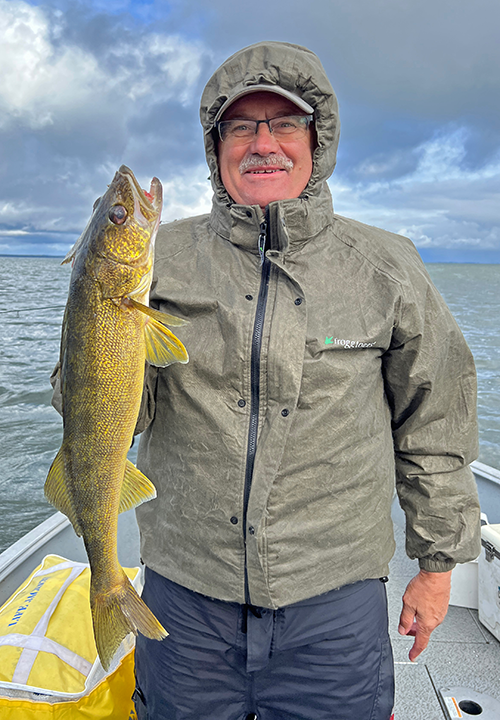 A cold, blustery west wind has been pushing hard into northern Minnesota this week. On Lake Winnibigoshish, where I’ve been fishing, it’s made the calmer, west side of the lake much more popular with anglers; I just wish that side of the lake had become more popular with walleyes too.
A cold, blustery west wind has been pushing hard into northern Minnesota this week. On Lake Winnibigoshish, where I’ve been fishing, it’s made the calmer, west side of the lake much more popular with anglers; I just wish that side of the lake had become more popular with walleyes too.
Don’t get me wrong, we were able to find some, and as you can see from the accompanying photos, some of them were beautiful fish. But compared to the “hot bite” we were enjoying on the east side of the lake last week; it feels quiet to me. Luckily, we weren’t locked into a “walleye or die” fishing trip and a strong run of Jumbo Perch made up for any slowdown of walleye action. Northern pike too, have keep some of the lines stretched while we’ve waited for the next walleye to strike.
Surface water temperatures dropped during the day on Thursday, at 62 degrees, a full 2 degrees lower than the 64 degrees that prevailed all week long. I expect to see a drop of another degree or 2 overnight, then barring a major league cold front, it should stabilize after it reaches about 60 degrees or so.
The cooling water, combined with all the other forces of nature at work, should trigger movement of not only walleyes, but most gamefish and baitfish too. So, for me, knowing whether there had previously been more walleyes on the west side of Winnie or not is a moot point. The incoming cold front and prevailing west northwest wind will change everything anyway. In fact, for all I know, schools of walleyes could already be making a push toward that western shoreline right now. That’s because walleyes tend to swim upstream, or into a current, when one small school moves in, they are soon joined by another one, and so on. Over time, the joining of smaller schools adds up and becomes what we perceive as a larger school of fish.
 The walleyes we did find on Thursday were in water depths of 7 to 9 feet. But on Wednesday, there were also a few of them mixed in with perch that were located much shallower. The “hot bite” for perch was going in about 4 feet of water and I’d guess that any walleyes that were there, had them in their crosshairs.
The walleyes we did find on Thursday were in water depths of 7 to 9 feet. But on Wednesday, there were also a few of them mixed in with perch that were located much shallower. The “hot bite” for perch was going in about 4 feet of water and I’d guess that any walleyes that were there, had them in their crosshairs.
The shallow water perch bite is not unique to the west side, I’ve heard similar reports from everywhere around the lake. Last week, we caught them in 2 to 5 feet of water on the south side too, and there has been similar shallow action in Third River and Cutfoot Sioux. The north shore has not been too accessible, so reports from that region are scarce, but today could be different. I see that northwest winds are predicted and that will allow folks, if they wat to, to explore the north shore.
Lightweight jigs are a must for fishing these shallow water fish because there’s a mossy carpet covering the bottom of the lake. Even when we use 1/16-ounce jigs, it fouls our hooks occasionally. We’ve done our best work by trolling slowly, at about .5 to .6 MPH and jigging on a short line. Using a vertical, hop-drop-hop-drop motion helps keep the lures clean too. Avoid side to side, horizontal jigging motions, that encourages your lures to drag along the bottom, gathering the moss constantly. From 2 to 6 feet of water, I’ve been using the 1/16-ounce jigs exclusively. From 7 to about 12 feet, we’ve tied on 1/18-ounce jigs, and from 13 to 22 feet, the ¼ ounce live bait jigs get the nod.
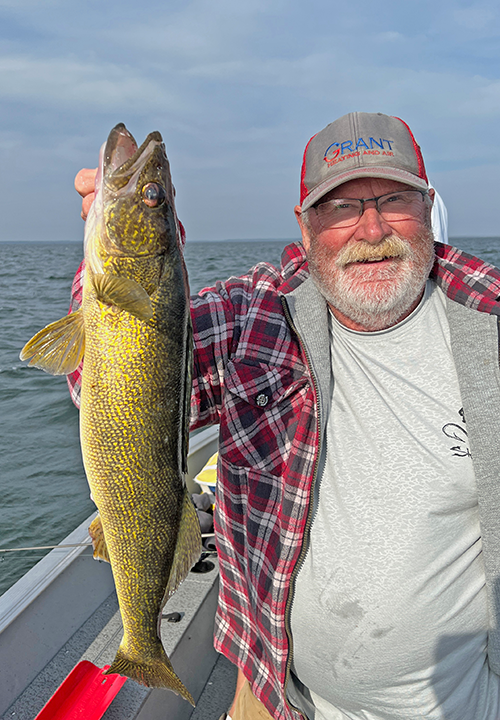 The minnow supply at Fred’s Bait in Deer River has been good lately, and I’ve been able to slip lazily into my fall season rut of making that my one and only daily stop. Yesterday, they had a nice run of river mix minnows, and there were some very nice size fatheads in the tanks too. I’ll try to do a better job of learning what supplies look like at some of the other bait shops in the region this week too. And, as always, you are welcome to provide your own updates about bait supplies at your favorite shops.
The minnow supply at Fred’s Bait in Deer River has been good lately, and I’ve been able to slip lazily into my fall season rut of making that my one and only daily stop. Yesterday, they had a nice run of river mix minnows, and there were some very nice size fatheads in the tanks too. I’ll try to do a better job of learning what supplies look like at some of the other bait shops in the region this week too. And, as always, you are welcome to provide your own updates about bait supplies at your favorite shops.
For a full week now, walleyes, along with the “bonus perch” I mentioned, have gotten all my attention and it seems that most folks have followed a similar program. So, panfish reports are skimpy this morning, but I think the colder weather will put them back on my radar. Typically, weather like this kills off some of shallow weed growth and forces both bait and panfish out into open water. I may even slip in a short session of crappie fishing today if the situation allows.
Resorts in the area are in various stages of winding down for the season. Some are closed altogether; others have slowed down or have shifted toward hunting vs fishing. For me, the season doesn’t end until October 25th, but now there are some spaces between fishing dates. That means that there may still be a few openings and recently, I offered some additional dates to subscribers of the “Insider News” email list.
The mailing list is strictly private, and I never share information, or add random email addresses. It is an opt-in only list, and signing up is both easy and fast. So, if you’re interested in updates about fishing trip availability or want an occasional reminder about fishing conditions in the region; sign up here >> The Early Bird Fishing Guide Insider News
If you’re on your way to the lake, good luck out there but please be safe. We have more windy and cold weather coming, and taking extra safety precautions isn’t just clever, it could save your life. If you see us on the lake, be sure to give a wave or swing by to say hello. ![]() — Jeff Sundin 218-245-9858 or EMAIL
— Jeff Sundin 218-245-9858 or EMAIL
 Cutfoot Sioux, Lake Winnie Fishing Report October 5, 2023
Cutfoot Sioux, Lake Winnie Fishing Report October 5, 2023
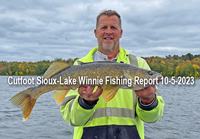 "The walleye action in Cutfoot has been good for our guests, and for our resident guide Jared Saufferer.
"The walleye action in Cutfoot has been good for our guests, and for our resident guide Jared Saufferer.
Walleyes in Cutfoot Sioux have been found in many of the most proven, popular spots. Hard bottom points that lead into deep water have been good, shallow patches of gravel and rock are good too, especially when located adjacent to vegetation. Fishing along the edges of cabbage and coontail can also be effective.
Walleyes in Winnie have been moving along the edges of mid-lake structures all week, and many have begun showing up along the shoreline, in shallower water. On any given day, we’ve heard about walleyes being caught in both deep and shallow waters. On mid-lake bars, 15 to 21 feet has been a key depth range. Along windswept shorelines, walleyes were caught in ..." Read >> Lake Winnie Cutfoot Sioux Fishing Report October 5, 2023 Jeff Sundin October 2, 2023 "Not Your Average Lake Winnie Fishing Report"
Jeff Sundin October 2, 2023 "Not Your Average Lake Winnie Fishing Report"
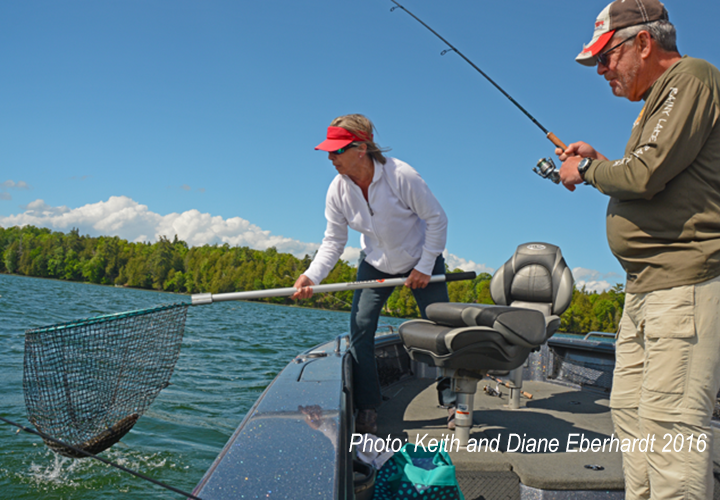 What happens to fishing guides, at least this one, is that customers, given time, become friends. Some closer than others, some faster than others, but eventually my relationship with almost everybody becomes something more than just business; that happened with Keith and Diane Eberhardt (pictured left).
What happens to fishing guides, at least this one, is that customers, given time, become friends. Some closer than others, some faster than others, but eventually my relationship with almost everybody becomes something more than just business; that happened with Keith and Diane Eberhardt (pictured left).
The Eberhardt’s rolled into my life back about 10 years ago when they were staying at Bowen Lodge on Winnie. We may have fished Winnie that day, or maybe we took a road trip to Bowstring, I can’t recall. I do remember though that having favorite lakes in common is one reason we hit it off. They loved fishing on Rainy, I love it too, they had history with Bowstring, so did I and there were others. Cutfoot Sioux and Winnie moved higher on their list of favorites though, and after a few years, they snapped up an opportunity to become cabin owners on the lake.
That cabin on Cutfoot Sioux provided a place for family and friends to gather and because of that, expanded the circle of friendship between the Eberhardt family and me. Fishing in recent years together with their daughter Laura and her family, also with Keith’s best friend Greg. We all were fortunate to have enjoyed those few years with Keith, but sadly, Keith passed away last winter.
 Even more sad, you could say, is that Keith’s passing occurred shortly after acquiring his “dream boat”, a brand new 20-foot glass tiller boat with all the candy. This summer, the boat spent more time on the lift than it did in the water, and I’m sure that’s not what Keith had in mind, and that is sad.
Even more sad, you could say, is that Keith’s passing occurred shortly after acquiring his “dream boat”, a brand new 20-foot glass tiller boat with all the candy. This summer, the boat spent more time on the lift than it did in the water, and I’m sure that’s not what Keith had in mind, and that is sad.
But on the other hand, this weekend Keith’s sparkle boat, in part, was the catalyst that elevated the Eberhardt and Sundin family friendships to a new, higher level. You see Ryan Eberhardt is at the lake this week helping Diane close the cabin for winter. But Diane wanted to be sure that his week was not all work, so besides chipping away at the list of chores, she scheduled a day on the lake with me. And because she was available this weekend too, Diane invited the Hippie Chick to join the party.
This obviously isn’t following the template of any “hard core” fishing report, especially because that part of the trip was almost too easy. The surface temperature on Winnie was 63 degrees and there was a light, but welcome algae bloom in the water. The weather was cool and cloudy, there was a light northeast wind forming a manageable chop on the surface. The walleyes were cooperative, the perch were too, at least they were until the wind stopped blowing at midafternoon.
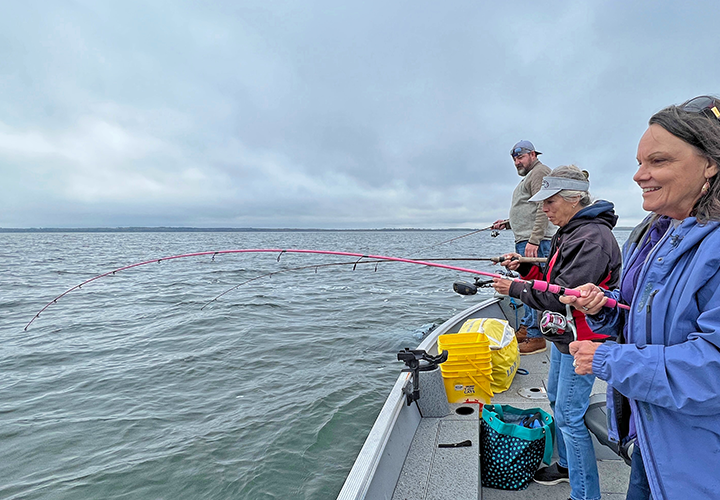 We found walleyes on the breaklines in water depths of 14 to 17 feet. Jigs and minnows were all we needed, the color of our ¼ ounce live bait jigs didn’t seem to matter. We used glow-blue, glow-pink, gold, and glow perch and they all worked equally well. Whether tipped with fatheads, dace, rainbows, or the occasional shiner minnow, strikes came regularly. I will say that the walleye strikes were tentative and light. Setting the hook too soon was a sure way to miss the fish. To catch them, we had to be patient, holding steady for 10 to 20 seconds and allowing the fish to consume the bait. As long as we did that, catching fish was not a problem.
We found walleyes on the breaklines in water depths of 14 to 17 feet. Jigs and minnows were all we needed, the color of our ¼ ounce live bait jigs didn’t seem to matter. We used glow-blue, glow-pink, gold, and glow perch and they all worked equally well. Whether tipped with fatheads, dace, rainbows, or the occasional shiner minnow, strikes came regularly. I will say that the walleye strikes were tentative and light. Setting the hook too soon was a sure way to miss the fish. To catch them, we had to be patient, holding steady for 10 to 20 seconds and allowing the fish to consume the bait. As long as we did that, catching fish was not a problem.
Before noon, we had 12 walleyes in the livewell for Diane and Ryan to take home, plus I and the Hippie Chick had 4 fish for dinner too. I would have loved to take Ryan crappie fishing, but the long boat ride back to the cabin, and the even longer ride to one of my preferred crappie lakes worked against the idea of changing lakes. The perch fishing on Winnie has been decent lately, so I opted to go that route instead.
Late last week, we found good numbers of perch on the weed flats in 7 to 9 feet of water. I high tailed it back to the area where we caught them and was surprised when they were not there. I, along with 20 or so other boats drifted the shallow breakline, waiting for something to happen, but it never did. Jake Premo, a fellow guide who fishes on Lake Winnie, had been catching perch lately, so I checked with him for intel. He’s the one who clued me in that I’d been fishing too deep. His advice was to try shallow, 2 to 4 feet of water.
I moved to the shallowest breakline along shore, a drop off from about 3 feet, down to about 6 feet of water and that's where they were. For us, 4 feet was the “sweet spot”, and for a time, it went well.
In water that shallow, 1/16-ounce jigs are the heaviest I can get away with. In fact, there are times when using a plain hook, without any weight works even better. If there was a chop on the surface, we were able to locate small packs of perch roaming the breakline, catching fish 2 or 3 at a time. Once the breeze stopped and the surface flattened, the pattern ended. I tried to find them in deeper water but did not find them fast enough. Instead, we wrapped our day by catching and releasing a few more walleyes using the same presentations as we did in the morning.
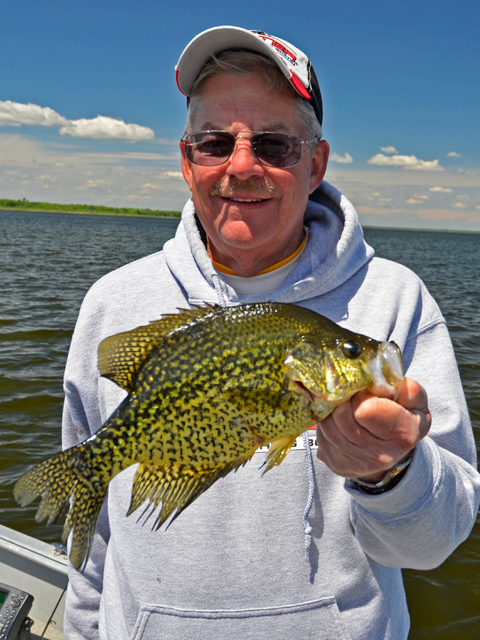 It felt like the whole point of this trip, on this day, was NOT that we were supposed to worry about catching fish. Instead, it was as if passing the torch to Ryan was supposed to be the over-riding goal. Ryan got some coaching from me about how to catch walleyes using a jig and minnow, which by the way, he had never done before. He got some rudimentary advice about controlling the boat and reading the graph too, maybe gleaning some tidbits of news that will help him and his family catch fish sometime down the road.
It felt like the whole point of this trip, on this day, was NOT that we were supposed to worry about catching fish. Instead, it was as if passing the torch to Ryan was supposed to be the over-riding goal. Ryan got some coaching from me about how to catch walleyes using a jig and minnow, which by the way, he had never done before. He got some rudimentary advice about controlling the boat and reading the graph too, maybe gleaning some tidbits of news that will help him and his family catch fish sometime down the road.
It seemed too that expanding the circle of friendship came into play on this trip as well. The Hippie Chick and Diane hit it off I think, and it won’t surprise me when they become closer friends. That could have happened sooner, we’d been invited to the cabin more than once before, but timing never worked out. I think it felt like those two were supposed to get together, and that this day was the one when it was destined to happen.
Destiny, preordination, good fortune, dumb luck? Or maybe guidance from a higher power? I honestly can’t say for certain how or why this trip came together the way it did, but I can say this, thank you Keith (Photo right, circa 2014) without you, none of it would ever have happened.
We all miss you, and we all remembered your every minute in all of our boats and I'm pretty sure that you were fishing with us this weekend too. Oh, and by the way, your big, sparkly dream boat is in good hands, at least I think so. ![]() — Jeff Sundin 218-245-9858 or EMAIL
— Jeff Sundin 218-245-9858 or EMAIL
 Wired2Fish October 2, 2023 "Power Fishing Bladed Jigs for Smallmouth with KVD"
Wired2Fish October 2, 2023 "Power Fishing Bladed Jigs for Smallmouth with KVD"
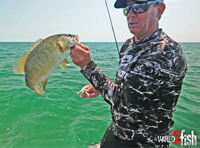 "Kevin VanDam takes to sprawling Lake St. Clair for a lesson in power fishing bladed jigs for big smallmouth bass. He underscores the efficiency of this approach in targeting both largemouth and smallmouth bass in expansive flats where covering ground is essential to locating fish. But unlike largemouth, bladed jigs remain overlooked for smallmouth.
"Kevin VanDam takes to sprawling Lake St. Clair for a lesson in power fishing bladed jigs for big smallmouth bass. He underscores the efficiency of this approach in targeting both largemouth and smallmouth bass in expansive flats where covering ground is essential to locating fish. But unlike largemouth, bladed jigs remain overlooked for smallmouth.
VanDam emphasizes the Thunder Cricket’s ability to generate strikes and big fish due to its sizable profile and unique vibration. Throughout the video, VanDam provides an in-depth look at his approach to fishing at varying depths and cover types, focusing on isolated grass patches and using his MEGA Live and 360 Imaging to understand his surroundings better. As he states, bass are rarely related to just sand. Combinations of sand, weed, and gravel seem to hold the most fish, showing clearing on his MEGA 360 Imaging.
While finesse tactics for smallmouth often excel, VanDam shares bladed jig and trailer selection criteria that add realism and improve success. He favors ..." Viewing Video to Learn More >> Power Fishing Bladed Jigs for Smallmouth with KVD
 Cutfoot Sioux, Lake Winnie Fishing Report September 29, 2023
Cutfoot Sioux, Lake Winnie Fishing Report September 29, 2023
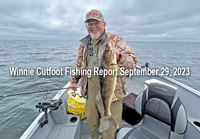 "Every fall, walleyes, perch, and pike make a push toward the shoreline, feeding both aggressively and often. So far, any full-scale migrations toward the shoreline have yet to begin. However, the annual fall trend toward feeding more aggressively and more often definitely has.
"Every fall, walleyes, perch, and pike make a push toward the shoreline, feeding both aggressively and often. So far, any full-scale migrations toward the shoreline have yet to begin. However, the annual fall trend toward feeding more aggressively and more often definitely has.
In part, the migrations are triggered by water temperature, and as surface temperatures are still holding in the 63-to-66-degree range, there’s been little incentive for gamefish to make a move. Food sources, another driving force in the fish’s urge to relocate, are literally everywhere right now, this also holds fish in place.
That cloud you see in the photo of our fish finder shows a large school of ..." Read >> Lake Winnie Cutfoot Sioux Fishing Report September 29, 2023
 Wired2Fish September 29, 2023 "Lithium Boat Batteries Performance | Why I Made the Change"
Wired2Fish September 29, 2023 "Lithium Boat Batteries Performance | Why I Made the Change"
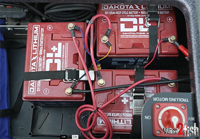 "When it comes to choosing marine batteries, there are a lot of technical differences to consider. In this video, John Murray discusses his shift to using lithium boat batteries in professional bass fishing. Due to the continuous use of power-intensive electronics, boat accessories, and boat control equipment, lithium marine batteries have been a smart shift for Murray.
"When it comes to choosing marine batteries, there are a lot of technical differences to consider. In this video, John Murray discusses his shift to using lithium boat batteries in professional bass fishing. Due to the continuous use of power-intensive electronics, boat accessories, and boat control equipment, lithium marine batteries have been a smart shift for Murray.
Murray underscores the importance of durable and reliable batteries, emphasizing his need for increased power and run times for today’s high-performance fish finders and trolling motors in 24V and 36V configurations. He elaborates on his previous reliance on lead-acid batteries and their shorter lifespan, leading him to explore and opt for a more efficient alternative: lithium iron phosphate batteries.
Murray discovered the advantages of ..." Learn More >> Lithium Boat Batteries Performance | Why I Made the Change
 Cutfoot Sioux, Lake Winnie Fishing Report September 22, 2023
Cutfoot Sioux, Lake Winnie Fishing Report September 22, 2023
 "It feels like we’re further away from fall this week than we were last week when we reported that fish were transitioning into fall fishing patterns. Warmer daytime air temperatures and more sunshine have momentarily stalled the cooling cycle. Surface temperatures remain steady, holding in a range between 63 and 66 degrees, depending on where we fish throughout all the connected lakes.
"It feels like we’re further away from fall this week than we were last week when we reported that fish were transitioning into fall fishing patterns. Warmer daytime air temperatures and more sunshine have momentarily stalled the cooling cycle. Surface temperatures remain steady, holding in a range between 63 and 66 degrees, depending on where we fish throughout all the connected lakes.
Lake Winnie and Cutfoot Sioux both still provide plenty of opportunities, but you’ll notice that certain methods, certain times of the day, and certain weather patterns bring out the best in which species will bite best, and when they’ll do it.
For Jared Saufferer, our “in house” fishing guide, jig and minnow combinations have been better for walleyes when fishing Cutfoot Sioux. On the main lake, where he’s been fishing primarily the north central shoreline structures, along with some of the deeper, mid-lake bars of Winnie, trolling spinners have ..." Read >> Lake Winnie, Cutfoot Sioux Fishing Report September 22, 2023 Jeff Sundin September 20, 2023 "Lake Winnibigoshish Fishing Report"
Jeff Sundin September 20, 2023 "Lake Winnibigoshish Fishing Report"
 On Lake Winnie, the progression of fall feeding patterns for walleye, crappie and perch are underway, in the early stages.
On Lake Winnie, the progression of fall feeding patterns for walleye, crappie and perch are underway, in the early stages.
Historically August, in particular late August, was always the time when many of us veteran guides expected walleye, perch, and pike activity to increase. For me, the correlation between the full moon of august and an uptick in fish activity was almost as predictable as the sunrise and sunset. In recent years though, the line that delineates the transition from summer into fall has been blurred. Recently, some days felt like the fall bite is on, and some days summer patterns seemed solid, but some days, there is a mix of both going on at the same time.
As of yesterday, surface water temperatures on the big lake were pegged at about 64 degrees. There has been a stiff breeze churning the water for the past 2 days, so I think that temperature is solid, and will hold steady for a while, until the next serious cold front arrives.
The lower water temperatures definitely have triggered some changes in walleye feeding behavior, and yellow perch appears to be on the move too. But so far, the uptick is spotty, fish activity starts up and then falls off daily, sometimes hourly. So, for me to provide consistent action for my customers, I’ve had to switch back and forth between classic summer presentations, and traditional fall methods.
On Monday, Karen and Erling Hommedahl were able to catch most, almost all their walleyes using jig and minnow presentations. Jigs and minnows were good last week too when Dick and Paul bagged a nice mess of large perch. But while we were fishing with jigs, some of my fellow guides were in the same area, trolling with spinners and they were catching fish too.
 On Tuesday, our morning began with “Bugs” getting off to a jack rabbit start using jigs and minnows on one of the large, mid-lake bars in about 17 feet of water. Then, the solid jig bite fizzled, and turned into an expert’s presentation; I could still elicit strikes and hook fish using jigs, but the crew was struggling. So, we moved into shallow water, hoping to cash in on a school of fish that had been active on Monday. The shallow flats we tried still held fish, but the jig and minnow bite still required expert skills. The crew was still watching me hook fish, but not catching their own and it was concerning.
On Tuesday, our morning began with “Bugs” getting off to a jack rabbit start using jigs and minnows on one of the large, mid-lake bars in about 17 feet of water. Then, the solid jig bite fizzled, and turned into an expert’s presentation; I could still elicit strikes and hook fish using jigs, but the crew was struggling. So, we moved into shallow water, hoping to cash in on a school of fish that had been active on Monday. The shallow flats we tried still held fish, but the jig and minnow bite still required expert skills. The crew was still watching me hook fish, but not catching their own and it was concerning.
Hoping to “fix” the problem, we switched over to trolling spinners in the shallow water. John started catching fish almost immediately and that was an improvement, but now he was the only one catching fish, while the rest of us watched. That was better than the problem I had before, so we went on like that for a little while, but I still had Jim to worry about, the one man who still hadn’t caught a fish. So, hoping that we could get the deep bite going again, we moved bag out to the bar and switched to heavier, ¼ ounce Lindy Live Bait Jigs and minnows.
Bugs was back in action, catching a keeper within a few minutes, John was coming on strong too and I even caught a fish too. Now I’m focused on one thing, figuring out how to get Jim a fish, at least one, before the day came to an end. “Jim, let me see your jig,” I said. I swapped out the large minnow for a smaller one, made sure it was on the jig just right and asked him to try this one. He cast the jig, let it fall into the water and as it fell, POP. He did it, Jim hooked one, we were all so happy that we could hardly contain ourselves; until it came off the line. Luckily, he got another chance and this time, he got the fish all the way to the net.
I went a long way to make my point, but here it is, the jig and minnow bite is on, but like I said, in the early stages. There will be times when you locate a school of active fish, and for a time, the bites will be robust. If the action drops off, don’t be too stubborn, leave that school of fish behind and go find a different one. The same thing will be true of presentations, use the jigs while they’re working, but don’t be shy about fishing spinners, crankbaits, or whatever other favored presentations you like to use.
I’m thinking that the fish should be more aggressive by this stage of the fall, but they’re running behind. That said, I can feel the activity intensifying, and I’m fairly confident that solid performances will soon become the norm, not the exception.
I am up against the clock and need to wrap right now, but there’s a major update coming in from Bowen’s soon, so watch for that report for additional details about what’s happening on Winnie and Cutfoot too. ![]() — Jeff Sundin 218-245-9858 or EMAIL
— Jeff Sundin 218-245-9858 or EMAIL
 Cutfoot Sioux, Lake Winnie Fishing Report September 15, 2023
Cutfoot Sioux, Lake Winnie Fishing Report September 15, 2023
 "Water temperatures dropped to the mid-60s about a week ago and then stabilized. Today, you’ll find temperatures on the big lake that range between 63 and 66 degrees; in Cutfoot, slightly warmer. In shallow water and protected back bays, vegetation has begun dying off, forcing some baitfish into areas where the grass is greener. Others have taken up residence in open areas over slightly deeper water, but not into the lake’s deepest mid-section.
"Water temperatures dropped to the mid-60s about a week ago and then stabilized. Today, you’ll find temperatures on the big lake that range between 63 and 66 degrees; in Cutfoot, slightly warmer. In shallow water and protected back bays, vegetation has begun dying off, forcing some baitfish into areas where the grass is greener. Others have taken up residence in open areas over slightly deeper water, but not into the lake’s deepest mid-section.
For walleyes, located on the edges of cabbage, coontail or mixed vegetation, summer trolling patterns can still provide action. Spinners tipped with minnows, or night crawlers are especially good during low-light periods at dusk or sunrise. On calmer days, or when conditions turn bright, moving out onto the flats will produce action too. Our guide, Jared Saufferer trolled spinners in 14 to 15 feet of water and showed some of our guests a very rewarding first ever walleye trip. For Jared, the north side of Winnie, everywhere from the gap, west to Mallard Point have produced reliable results.
When the wind blows, especially on cloudy days, drifting the shallow breaklines, or on shallow rocky structure using jig and minnow combinations are more efficient. Walleyes are responding to jigs better every day, and on the big lake, perch and pike ..." Read >> Bowen Lodge, Lake Winnie Fishing Report September 15, 2023
 Jeff Sundin September 13, 2023 "Winnie Perch Fishing Fun with Dick and Paul" MMXXIII Session II
Jeff Sundin September 13, 2023 "Winnie Perch Fishing Fun with Dick and Paul" MMXXIII Session II
 During our fish dinner at Florio’s last night, Paul Kautza commented, “It’s not very often that we ever single out one fish species, target a single lake, and then go after them successfully. It’s even more unusual to do the same thing three days in a row, targeting a different species and lake each day, and being successful on all of them.” I think Paul is right, it is unusual, at least it’s unusual for me.
During our fish dinner at Florio’s last night, Paul Kautza commented, “It’s not very often that we ever single out one fish species, target a single lake, and then go after them successfully. It’s even more unusual to do the same thing three days in a row, targeting a different species and lake each day, and being successful on all of them.” I think Paul is right, it is unusual, at least it’s unusual for me.
If you haven’t already read reports about walleye and crappie fishing on Sunday and Monday, you can review them here. Monday 9-11 Walleye Report Tuesday 9-12 Crappie Report
If you’re already up to speed, then recall that on Tuesday, I promised a report about perch fishing with Dick and Paul.
Don’t get me wrong, I don’t mean to sound gloomy, we can still find perch, and there are still opportunities to catch quality size fish. But Yellow Perch these days is the one species of fish that stresses me out the most. Generally, finding them in large numbers is clearly not as easy as it once was. That’s especially true when I’m fishing with folks who are selective about the average size of fish they want to harvest. That’s why I was pleasantly surprised when Wiinibiigoonzhish, (Ojibwe for Lake Winnibigoshish), sent us home with a couple dozen good ones yesterday.
The fish we found were located on the lake’s west side, along the shoreline’s drop off in about 8 feet of water adjacent to weedy flats. Wherever the weeds were still green, the perch were located amidst the vegetation, but most of them were in the open, just outside of grass. Surface water temperatures have dropped, 64 to 66 degrees was the range we observed yesterday, and the shallow weeds are in decline. Eelgrass was still somewhat green, but there were also some unidentifiable grasses that have turned black, soft, and difficult to fish in.
The wind was fairly strong and formed whitecaps atop the 1-1/2-foot waves. Trolling spinners would have been possible, but not that fun in the chop, so we used jigs and minnows almost exclusively. The standard 1/8-ounce live bait jigs collected a lot of moss and that wasn’t fun either. But if we were willing to put up with the “goo”, we did catch fish.
The action was slow-but-steady, fish were in small groups and were scattered along the shoreline. At one point, we drifted several hundred yards, catching fish sporadically along the entire route. If there had been some more well-defined structure, like a green patch of weeds or a rock pile, they would have been more concentrated. Reports from the north side of the lake, and from Cutfoot Sioux have indicated more tightly formed schools of fish on those types of structures.
Action on the south shore has also been good, and reports indicate similar fishing depths and structure preferences there as well. At the end of the day, we stopped near the bird houses and caught a few, but didn’t locate what I’d call a hot bite.
I had considered some other lakes too, but Winnie got the nod partly because of friends reporting decent catches, but also because of Dick and Paul’s special connection to the lake. I know they’ve been fishing there for at least 50 years, a decade more than me. I’m glad we fished Winnie yesterday, the perch action was not wild and wooly, but it was not slow either. Somebody was always on the verge of catching something, and besides perch, there was a handful of walleyes and pike in the area too. We harvested 1 bonus pike, destined to become a meal of “Coconut Pike Delight”. We also captured 4 walleyes for dinner, which like I said, we had at Florio’s last night.
The goal-oriented part of me wants to help the boys gather some more perch, and it would be tempting to make a return trip to the big lake. Today though, I think I’m going take them out of familiar territory and share a new, to them, lake. You’ll know how that works out soon enough, but for tomorrow, there will be another fresh update coming in from Bowen’s on Winnie, so stay tuned for that one first. ![]() — Jeff Sundin 218-245-9858 or EMAIL
— Jeff Sundin 218-245-9858 or EMAIL
 Cutfoot Sioux, Lake Winnie Fishing Report August 25, 2023
Cutfoot Sioux, Lake Winnie Fishing Report August 25, 2023
 "Walleye fishing on Lake Winnie has generally remained good, but not for everybody. While the fish do bite when found, getting consistent results depends on a combination of weather conditions, location, angler skill, and determination. Among our guests who are doing the best are the early risers, evening anglers and ones who head out when conditions are windy and grey. Creativity comes into play too, presentations change, seemingly daily, so, folks who offer the fish several options get more “takers” than the folks who stick with any single presentation.
"Walleye fishing on Lake Winnie has generally remained good, but not for everybody. While the fish do bite when found, getting consistent results depends on a combination of weather conditions, location, angler skill, and determination. Among our guests who are doing the best are the early risers, evening anglers and ones who head out when conditions are windy and grey. Creativity comes into play too, presentations change, seemingly daily, so, folks who offer the fish several options get more “takers” than the folks who stick with any single presentation.
Water clarity and temperature are contributing factors, surface temperatures have dropped out of the 70s, holding steady now at 68 to 69 degrees. Algae blooms have declined in response and the water has cleared noticeably. Sunshine, calm water and angler traffic move fish out of the easy to reach structures during the day. But when the weather is rough, and the skies are dark, get ready because walleyes will move in to... Read >> Lake Winnie Fishing Report August 25, 2023
 Cutfoot Sioux, Lake Winnie Fishing Report August 5, 2023
Cutfoot Sioux, Lake Winnie Fishing Report August 5, 2023
 "Aided by the lowered light conditions walleyes, at least some of them, have moved into classic, late summer habitat like shoreline breaks, mid-depth gravel flats and areas of submerged vegetation. Lower light penetration into the water, combined with rising surface temperatures that affect fish behavior, helps explain why our guests were able to catch fish this week using trolling presentations.
"Aided by the lowered light conditions walleyes, at least some of them, have moved into classic, late summer habitat like shoreline breaks, mid-depth gravel flats and areas of submerged vegetation. Lower light penetration into the water, combined with rising surface temperatures that affect fish behavior, helps explain why our guests were able to catch fish this week using trolling presentations.
Spinners, tipped with live bait, provided action for some of our guests who fished shoreline breaks. Crankbaits trolled over the flats, in 12 to 16 feet of water provided action for folks fishing some of the mid-lake structures on Big Winnie. Cutfoot walleyes responded to jigging raps fished on shoreline points, and some of the mid-lake bars. Our guide, Jared Saufferer, is still catching fish using slip-floats and live bait, but he acknowledged that trolling spinners has worked as well.
Despite the improved conditions, not all the walleyes ..." Read >> Lake Winnibigoshish Fishing Report August 5, 2023 Cutfoot Sioux, Lake Winnie Fishing Report July 24, 2023
Cutfoot Sioux, Lake Winnie Fishing Report July 24, 2023
The rule of thumb for walleye fishing on Lake Winnie this morning is “the better the angler, the better the fishing”. Casual anglers are catching their share of fish, there are plenty of fish to go around, and they are biting. Results are awesome for folks who pursue them diligently, or you could say “working” for the fish.
Look at the results from the weekend tournament, managed by the Minnesota Tournament Trail. All the top 20 teams weighed in 5 fish, the tournament limit, and all of those 5 fish limits exceeded a 3-pound average. The top 10 teams fared even better: posting 4 pound plus averages. Congratulations by the way, to our friend Dusty Snyder, who along with Pat Mclean posted took 2nd place with a 5 fish weight of over 25 pounds.
Locating fish using high end electronics, then using slip bobbers and live bait, leeches, and night crawlers specifically, has gotten a lot of attention this year. In some circles, the buzz is that without them, fish cannot be found, and subsequently caught. It is important to remember though that even without sophisticated tools, you can still ... Read Full Report >> Cutfoot Sioux, Lake Winnie Fishing Report July 24, 2023
 Cutfoot Sioux, Lake Winnie Fishing Report July 14, 2023
Cutfoot Sioux, Lake Winnie Fishing Report July 14, 2023
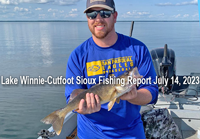 "Admittedly, the walleye bite is not at its peak right now, but those who are choosing to fish for walleyes find that creativity and persistence do pay off. Getting fish to bite is not the issue but locating them can be. That’s because fish have dispersed over a broad range of territory, some are on the flats, some are using shoreline vegetation, others follow the breaklines on deep structure and many are suspended over open water in the mid lake basin.
"Admittedly, the walleye bite is not at its peak right now, but those who are choosing to fish for walleyes find that creativity and persistence do pay off. Getting fish to bite is not the issue but locating them can be. That’s because fish have dispersed over a broad range of territory, some are on the flats, some are using shoreline vegetation, others follow the breaklines on deep structure and many are suspended over open water in the mid lake basin.
The mayfly hatch that hit the lake last week has run its course, so finding less food in concentrated areas has been one reason fish are dispersed more now. Surface waters have declined too, once crossing the 80-degree mark in June, they have now fallen into the 69-to-71-degree range, the cooler water works against folks who love fast presentations like trolling spinners and crankbaits. Water clarity is a factor as well, while some regions of the lake do have a modest algae bloom, other areas remain clearer and ..." Read Full Report >> Cutfoot Sioux, Lake Winnie Fishing Report July 14, 2023
 Wired2Fish "Speed Fishing Deep-Diving Crankbaits for Summer Bass" July 12, 2023
Wired2Fish "Speed Fishing Deep-Diving Crankbaits for Summer Bass" July 12, 2023
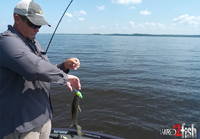 "Wired2fish connected with Keith Combs on his home water of Sam Rayburn, Texas, for a lesson on finding offshore bass and catching them on deep-diving crankbaits. This video provides a step-by-step guide to using modern fish finder technologies to locate productive summer spots and power fishing crankbaits with speed to trigger lethargic bass.
"Wired2fish connected with Keith Combs on his home water of Sam Rayburn, Texas, for a lesson on finding offshore bass and catching them on deep-diving crankbaits. This video provides a step-by-step guide to using modern fish finder technologies to locate productive summer spots and power fishing crankbaits with speed to trigger lethargic bass.
Combs highlights the critical role that cutting-edge electronics play in his angling strategy. His reliance on fish finders allows him to find overlooked bass schools in deeper waters despite increased angling pressure. He uses side imaging and mapping to find offshore bass schools. From there, 360 Imaging and forward-facing sonar (MEGA Live Imaging) provide real-time information on the bow to ..." View Video and Learn More >> Speed Fishing Deep-Diving Crankbaits for Summer Bass
 Cutfoot Sioux, Lake Winnie Fishing Report July 3, 2023
Cutfoot Sioux, Lake Winnie Fishing Report July 3, 2023
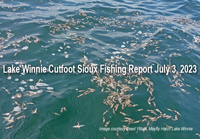 "It had to happen eventually, the heat on Lake Winnie’s “BOILING HOT” walleye bite has been reduced to a simmer. Our guests and fellow anglers are still bringing in fish, but at a slower pace than we enjoyed throughout the spring.
"It had to happen eventually, the heat on Lake Winnie’s “BOILING HOT” walleye bite has been reduced to a simmer. Our guests and fellow anglers are still bringing in fish, but at a slower pace than we enjoyed throughout the spring.
One reason for the reduced catch rates is thought to be the mayfly hatch that’s going on now. With lots of extra food in the water, walleyes, other predators too, can be more particular about how often, and for how long, each feeding session will occur. To the fish, it’s a lot like us being offered a peanut butter sandwich and hour after finishing a huge, holiday meal like the thanksgiving turkey for example.
Insect hatches occur over a wide variety of areas, so beyond providing more food, they also ..." Read Full Report >> Cutfoot Sioux, Lake Winnie Fishing Report July 3, 2023
 Jeff Sundin June 30, 2023 "Winnie Walleyes Scattered, Un-Patternable, But Biting"
Jeff Sundin June 30, 2023 "Winnie Walleyes Scattered, Un-Patternable, But Biting"
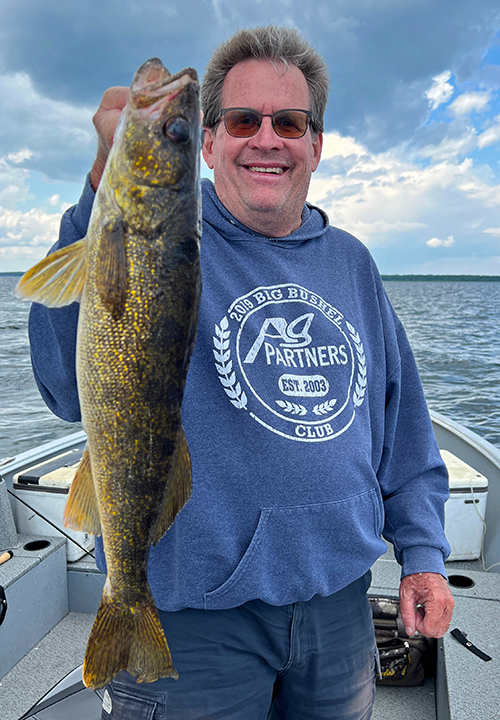 Have you ever discovered 1 walleye lure, or 1 presentation, or 1 fishing pattern that works 100% of the time? If you have, you’re not only lucky, but you are miles ahead of me, because I never have.
Have you ever discovered 1 walleye lure, or 1 presentation, or 1 fishing pattern that works 100% of the time? If you have, you’re not only lucky, but you are miles ahead of me, because I never have.
If I’ve ever needed a perfect example of how “Un-Patternable”, but still biting walleyes can be, yesterday’s trip on Lake Winnibigoshish is the one. To illustrate, let me give you the list of presentations that helped us catch walleyes yesterday.
- Jig and Shiner = 4 or 5 walleyes caught, additional 4 or 5 hooked but lost.
- Jig and Ripple Shad = 1 Walleye
- Wiggle Worming = 1 Walleye
- Spinner and Shiner Combo = 1 Walleye
- Spinner and Crawler Combo = 2 Walleyes
- Spinner and Leech Combo = 6 Walleyes
- Mid-Lake Bars = Yes
- Mid-Depth Flats = Yes
- Shallow Gravel/Rock = Yes
- Open Water Trolling = Yes
There was a moment early in the day, when I “Believed” that we would be fishing mid-lake bars and humps, and that we would be using jigs and minnows all day. The idea was supported when Joel, on his first cast, caught a 24-1/2 walleye on a jig and shiner. Not long afterward, Joel caught and released a couple more smaller fish too. After a pass or two, the action slowed and I started searching for a new spot and found a couple, but the story repeated, find fish, catch a couple, and then watch the action fizzle out.
Somewhere along the line I had mentioned that we might have to go into “emergency trolling mode”, but at the time, I was still thinking that jigs were “working”. At one stop, Ross either remembered my earlier comment, or came up with the idea himself to drop a spinner into the water. We were moving too slow for the spinner to work effectively, so it was time for a full-scale test of Ross’ idea. I pulled out the spinner poles and passed them around, then began trolling on the flats. The action didn’t take off like a rocket, but trolling did work and for Dan, the idea was a great one. The image (upper left) of his fat 24-1/2-inch walleye represents Dan moving a notch higher on the learning curve and put him that much closer to being a walleye pro, like his buddies.
 Scattered, and un-patternable, they may be, but inactive, they are not. Throughout the day, one thing was always true, if I could see fish on my graph, they would bite. So, I guess the takeaway from today’s report should be that creativity and determination will surely help you gather enough walleyes for a fish fry. If you catch a few and then the action fizzles, then move to a new spot. If you catch them on one presentation and the action fizzles out, then try another presentation.
Scattered, and un-patternable, they may be, but inactive, they are not. Throughout the day, one thing was always true, if I could see fish on my graph, they would bite. So, I guess the takeaway from today’s report should be that creativity and determination will surely help you gather enough walleyes for a fish fry. If you catch a few and then the action fizzles, then move to a new spot. If you catch them on one presentation and the action fizzles out, then try another presentation.
If your fishing partner offers an idea, like Ross did yesterday, then follow it because the idea might be spot-on. Finally, if folks are grumbling about fish that “aren’t biting”, don’t be influenced, just go out and fish until you find something, eventually you will win.
For me, the mixed bag action bite is back on the agenda today and from what I learned yesterday, Winnie won’t be the place to do that. Yes, we did catch walleyes, but at the end of a full day of fishing, we had never touched a single fish of any other species. No pike, no perch, no nothing else. That’s probably because we didn’t get into the weeds, so if you’re headed for Winnie for pike, perch or panfish, that’s probably where you should start your search.
I’m anticipating am Independence Day update from Bowen’s, so even if I don’t get back to Winnie this weekend, there will be a fresh update from them soon, so check back for that too.
If you’re headed for the lake to celebrate the holiday, good luck out there! ![]() — Jeff Sundin 218-245-9858 or EMAIL
— Jeff Sundin 218-245-9858 or EMAIL
 Wired2Fish June 9, 2023 "How to Find and Catch Grass Bass with ChatterBaits"
Wired2Fish June 9, 2023 "How to Find and Catch Grass Bass with ChatterBaits"
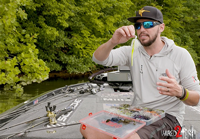 "Professional bass angler Carl Jocumsen shares his process for finding the highest-percentages grass spots and fishing them efficiently with a ChatterBait. Join us as we show you how to locate the best-looking spots using mapping and sonar and quickly fish them with bladed jigs
"Professional bass angler Carl Jocumsen shares his process for finding the highest-percentages grass spots and fishing them efficiently with a ChatterBait. Join us as we show you how to locate the best-looking spots using mapping and sonar and quickly fish them with bladed jigs
Covering Water and Locating Fish
Like offshore fishing, grass fishing involves identifying contours and structures to locate bass. Jocumsen starts his search by analyzing mapping to find shallow water structures. He then uses MEGA 360 Imaging with MEGA Live to find the best-looking grass and confirm the presence of fish.
Jocumsen shares his insights on using ChatterBaits in grass fishing scenarios. ChatterBaits owe their versatility to a wide range of sizes and colors. Once you figure out what the bass want, it’s easy to ..." View Video and Learn More >> How to Find and Catch Grass Bass with ChatterBaits
 Cutfoot Sioux, Lake Winnie Fishing Report June 23, 2023
Cutfoot Sioux, Lake Winnie Fishing Report June 23, 2023
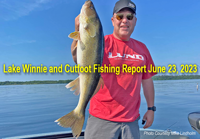 "Walleyes in both Lake Winnie and Cutfoot Sioux are in a seasonal transition. While some fish remain in relatively shallow water, 8 to 16 feet for example, others are migrating out to mid-lake structures. Instead of finding large, concentrated schools of fish, it’s more common now to find small schools of fish, in a wide variety of locations. So, exploration of fresh territory will pay off bigtime for anglers hoping to find a “hot bite”.
"Walleyes in both Lake Winnie and Cutfoot Sioux are in a seasonal transition. While some fish remain in relatively shallow water, 8 to 16 feet for example, others are migrating out to mid-lake structures. Instead of finding large, concentrated schools of fish, it’s more common now to find small schools of fish, in a wide variety of locations. So, exploration of fresh territory will pay off bigtime for anglers hoping to find a “hot bite”.
On Wednesday, anglers located good schools of fish in shallow water, not far from the resort. Fishing with jig and minnow combinations, they captured limits of keeper walleyes, and released a good number of larger fish too. At the same time, there were anglers fishing mid-lake structures and they found walleyes too. Whether you fish shallow or deeper depends on your fishing preferences.
Water temperatures have stabilized, and are solidly holding at about 71 degrees, varying by 1 or 2 degrees between day and night. Water clarity has begun to change, there is a slight-but-noticeable algae bloom taking hold in the big lake, somewhat stronger in Cutfoot Sioux. Insect hatches have ..." Read Full Report >> Cutfoot Sioux, Lake Winnie Fishing Report June 23, 2023
 Cutfoot Sioux, Lake Winnie Fishing Report June 16, 2023
Cutfoot Sioux, Lake Winnie Fishing Report June 16, 2023
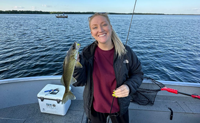 "We’ve issued numerous reports in recent years about fishing “The New Winnie”, and offered solid tips on how to approach walleye presentations that work with, not against, the clear water conditions. This summer, we’re seeing evidence that many anglers have taken those tips to heart. They have adapted to the clear water and their creels, filled with walleyes, offer proof that the adaptations have been effective.
"We’ve issued numerous reports in recent years about fishing “The New Winnie”, and offered solid tips on how to approach walleye presentations that work with, not against, the clear water conditions. This summer, we’re seeing evidence that many anglers have taken those tips to heart. They have adapted to the clear water and their creels, filled with walleyes, offer proof that the adaptations have been effective.
Fishing the twilight period, for example, is one of the key adaptations. Formerly reserved for sitting by the campfire, fishing at sunset has now become very popular with our guests. They’ve experienced the transformation from lethargic, daytime feeding patterns to aggressive, even gluttonous at times, walleye feeding behavior during the crepuscular feeding periods. Our guide, Jared Saufferer says; “The bite continues to ..." Read >> Lake Winnie Cutfoot Sioux Fishing Report June 16, 2023
 Cutfoot Sioux, Lake Winnie Fishing Report June 9, 2023
Cutfoot Sioux, Lake Winnie Fishing Report June 9, 2023
 "Surface temperatures, at their peak reached the high 70 to low 80-degree range. After a cooler, breezier weather pattern developed at mid-week, Winnie’s waters were churned by the choppy water and temperatures settled back in to the 72-to-73-degree range.
"Surface temperatures, at their peak reached the high 70 to low 80-degree range. After a cooler, breezier weather pattern developed at mid-week, Winnie’s waters were churned by the choppy water and temperatures settled back in to the 72-to-73-degree range.
The warm water generated a moderate algae bloom and that added some color to the “gin-clear” water in Lake Winnie, which had previously been a problem for walleye anglers on sunny days. There haven’t been any large-scale insect hatches so far, but evidence is mounting that there will be some soon. Walleyes caught on the mid depth flats are coughing up insect larvae in folks’ live wells and tiny white, gnat-like bugs have been hatching over the deep-water mud flats.
The development of submerged vegetation has influenced walleye location too. Earlier this week, walleyes were caught in good numbers by anglers fishing cabbage patches in shallow, 4- to 7-foot-deep water. With the ever-growing food chain, reduced light penetration, and blooming vegetation, the array of angler’s choices has ..." Read >> Lake Winnie Cutfoot Sioux Fishing Report June 9, 2023
 Cutfoot Sioux, Lake Winnie Fishing Report June 1, 2023
Cutfoot Sioux, Lake Winnie Fishing Report June 1, 2023
 "On Lake Winnie, shiner minnows typically begin spawning around Memorial Day, and that pattern was on track this week. So, we think that the shoreline bite will continue for a week or so, especially in areas adjacent to the sprawling sand flats where shiners perform their spawning cycle. Small perch and other baitfish move onto the same shallow flats where shiner minnows are spawning, and these add to the attraction for hungry walleyes.
"On Lake Winnie, shiner minnows typically begin spawning around Memorial Day, and that pattern was on track this week. So, we think that the shoreline bite will continue for a week or so, especially in areas adjacent to the sprawling sand flats where shiners perform their spawning cycle. Small perch and other baitfish move onto the same shallow flats where shiner minnows are spawning, and these add to the attraction for hungry walleyes.
Clear water conditions favor fishing during the twilight periods during morning and evening. Key walleye depths range from 12 to 18 feet along shoreline, shoreline related points and rocky structure also provide decent walleye action. During the daytime, especially on calm days, walleyes slip deeper down the breakline, preferring the 22-to-26-foot depth range. In the dark of night, they’ll move over shallow flats in the 10-to-14-foot range, maybe shallower at times.
Jig and minnow combinations continue to be the prominent presentation for our guests. Jig weights of 1/8 ounce are sufficient during twilight when walleyes move shallow. During the day, ¼ to 3/8-ounce weights are required to maintain contact with walleyes. Shiners are readily available now, and do appear to provide an advantage on Winnie, but larger fatheads or rainbows will ..." Read >> Lake Winnie Fishing Report June 1, 2023
 Reader Comments May 31, 2023 "Dan Hamilton Lake Winnie Fishing Report"
Reader Comments May 31, 2023 "Dan Hamilton Lake Winnie Fishing Report"
On Tuesday (May 30, 2023), Dan Hamilton emailed with a fishing report along with a couple of questions resulting from his Memorial Weekend fishing trip Lake Winnie.
"Hi Jeff, I rolled in to camp at 12:30 am Friday morning. This was my first trip to winni. Instead of making a bunch of noise setting up camp I decided to get on the water. I trolled raps in 8-10' of water on a wind blown shore line from 1am to after sunrise. I boated 41 walleye, biggest was just over 28" and about half were slot fish. The northern lights were out for a bit and the sunrise was incredible. I didn't see anyone else on the lake.
After the kids arrived late friday, we trolled rapalas from 9 - midnight with the kids. We boated 11 walleye with 1 slot fish. The kids struggled a bit learning to 'read' planer boards and I'm sure the constant reeling in and letting back out negatively impacted the results.
Saturday morning the girls trolled spinners early (minnows and crawlers both worked) and did well in wind blown shallower back water areas with a mixed bag of mostly walleye, a few pike and some jumbo perch. Mid morning, the boys wanted to cast so we went out to fish jig & minnow and caught just a couple walleye. When the girls got in the boat after lunch we went back to trolling spinners and the action picked up again with a mixed bag including 8 eater walleye and several slot fish.
Sunday was pretty much a repeat. The boys wanted to cast so we tried jigs & minnows again and then casting cranks with minimal success. The girls hopped in the boat again after lunch, we pulled spinners in the same areas the boys just fished and the action was great with a mixed bagging including the biggest rock bass I have ever seen. After dinner, we went to one of the community holes where the boats were piled up casting jigs or fishing bobbers. We pulled spinners on the outside edges of the group and it seemed like we were catching walleye 2:1 compared to the people not moving.
I'm relatively new to walleye fishing (I grew up fishing trout in gin clear streams). Last summer was our first year chasing walleye and it was a rough start. People we talked to said try jigging and we had poor results. In late June we started trying lindys with leeches and then spinners with crawlers (usually behind bouncers), our results improved immediately. We intended to try chasing the fall bite but I had a cancer diagnosis in early September that pretty much derailed fall and early ice seasons for us.
This year we started the season off on the duluth area reservoirs with spinners/bouncers (minnows and crawlers both worked) and had excellent success while it seemed like other people we talked to were struggling while fishing jigs.
Q) I'd like to learn jig fishing but so far I don't really see the attraction? Is jigging as effective as pulling spinners? Any tips for how to get better at fishing jigs?
Another question I have is what do you do to protect your hands while guiding? I do the baiting and fishing handing while fishing with my girlfriend and daughter. My hands are shredded from walleye/perch spines and gill plates after this weekend and I'm pretty sure a couple of the spine wounds are getting infected. How do you guide day after day and keep your hands in good shape? Thank you, Dan"
A) Dan, thank you for the reports and for the questions too. Let’s take the easy question first, how to maintain healthy fingers and hands when handling lots of spiny fish.
The trick for situations where minor abrasions and tiny cuts occur, I use camphor to help prevent them from getting worse. The all-time greatest I ever found was a now discontinued hand lotion called “Walgreens Medicated Hand Healer.” When they stopped selling it, I looked up the active ingredients and discovered that there were only 2, strong ammonia and camphor. My wife looked camphor in liquid form so I could try mixing my own but found instead a camphor cream. I’ve been using this and like the old hand healer, it also helps close tiny wounds.
For larger cuts that occur, super glue is the best remedy. Get the cut as dry as possible, apply a drop of super glue into the cut and press, using firm pressure until the adhesive sets. Keeping the wound sealed reduces pain and also helps heal faster too.
When your hands get dry, cracked and sore, use Aloe. Cutting a fresh piece from a plant is great, but if you don’t have one growing at home, buy a bottle of 100% aloe at the store. This is very good, promoting faster healing and reducing pain too.
Jig and minnow fishing for walleyes is not only productive, but at times, much more efficient than trolling. I will tackle this one soon, but right now I’m up against the clock and have to run. Please watch the reports in the days ahead and I will get to it as fast as I can. ![]() — Jeff Sundin 218-245-9858 or EMAIL
— Jeff Sundin 218-245-9858 or EMAIL
 Cutfoot Sioux, Lake Winnie Fishing Report May 25, 2023
Cutfoot Sioux, Lake Winnie Fishing Report May 25, 2023
 "Regions of the lake with the coolest water temperatures also feature the clearest water conditions. Walleyes in these regions show a strong preference for feeding during low light periods. Anglers do report catching some fish during the daytime. But in the words of one guest whose here right now, “The evening bite is on fire, when the sun starts touching the treetops, the fish start feeding. We’re fishing in water depths of 16 to 20 feet using ¼ ounce jig heads and minnows.”
"Regions of the lake with the coolest water temperatures also feature the clearest water conditions. Walleyes in these regions show a strong preference for feeding during low light periods. Anglers do report catching some fish during the daytime. But in the words of one guest whose here right now, “The evening bite is on fire, when the sun starts touching the treetops, the fish start feeding. We’re fishing in water depths of 16 to 20 feet using ¼ ounce jig heads and minnows.”
Warmer water, with darker color translates into a whole new story for folks fishing those regions. One of the better area guides says this, “On Wednesday, we fished in the extreme back regions and found 61.5-degree water. “There were some scattered, but still green cabbage plants, along with some stubby, newly emerging vegetation too. There were walleye, perch and smaller northern pike using feeding there.”
“We caught a mixed bag of fish by moving slowly along the ..." Read >> Lake Winnibigoshish Cutfoot Sioux Fishing Report May 25, 2023 Jeff Sundin May 21, 2023 "Too Stubborn Not To Have A Happy Ending"
Jeff Sundin May 21, 2023 "Too Stubborn Not To Have A Happy Ending"
 Last week, I and the Hippie Chick were chatting about weekend plans when she discovered a rare gap in her social calendar. So., I asked my friend and customer Ken Seufert if he was interested in having a first mate on board yesterday’s fishing trip. He agreed, and we set the time to meet at McArdle’s Resort on Winnie’s west side. We met there because the weather forecast called for gusty west winds; naturally, they never did gust, buts that’s a story for another time.
Last week, I and the Hippie Chick were chatting about weekend plans when she discovered a rare gap in her social calendar. So., I asked my friend and customer Ken Seufert if he was interested in having a first mate on board yesterday’s fishing trip. He agreed, and we set the time to meet at McArdle’s Resort on Winnie’s west side. We met there because the weather forecast called for gusty west winds; naturally, they never did gust, buts that’s a story for another time.
For me, fishing on the west side of Winnie has not been very productive recently, I’ve had much better luck on the north end. But you can’t find new spots unless you venture into fresh territory, and I stopped at 3 or 4 places, having high hopes for all.
I found water temperatures ranging from 49 degrees up to about 52 degrees and the water was gin clear. Not a great scenario for sunshine and calm seas, I looked shallow and deep, but after watching a blank screen on my graph for an hour, I headed back for the north side, territory that has been productive recently.
“It’s Saturday, the weather is nice, and the breezes are light, there’s gonna be a crowd”, I thought to myself as we were motoring. The crowd was large when we arrived, but there was little bit of wiggle room, so we settled in for our first pass. Within minutes, Ken had caught a 17-inch walleye, I got one too and then Susan caught a coveted 26-inch pike for our supper. It looked like we were off to the races, but we weren’t.
The rest of my morning featured a series of wrong turns, I went to places where we’d caught fish in recent days and found that they had moved. I guessed at a few new areas to check but found most of them empty. I even followed up on a hot tip I got from a fellow guide who had done well in the morning, but the spot had fizzled out by the time we arrived. Long story short, we headed into the afternoon with 3 walleye and 1 pike in the livewell, disappointing to me, even if my crew did not seem very upset. I overheard Ken telling Susan not to worry, he had faith that I’d figure something out, I hoped he was right.
In May, I don’t usually leave the big lake, but my little voice was nagging me about heading for the back bays and darker water. “What if there are a bunch of fish that haven’t moved away from their spawning territory? I asked myself. I told my crew what I’d been thinking and explained that it wouldn’t be any worse than we were doing and followed my intuition. We headed way back into the backwaters and found ourselves sitting in 62-degree water, with a light chop on it, just enough to drift the boat.
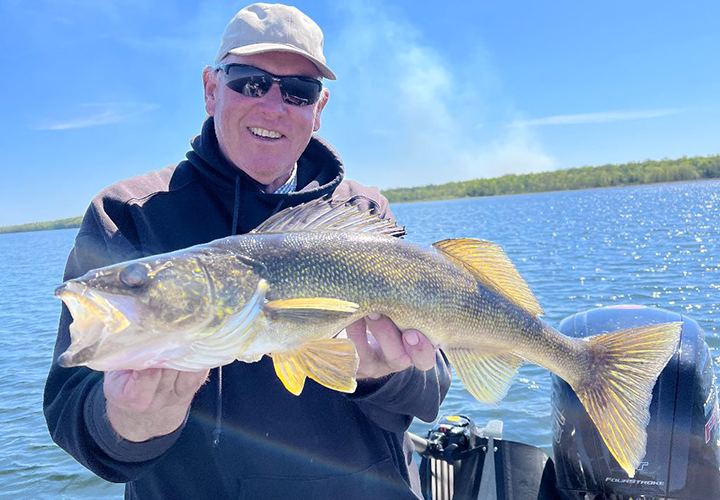 We got into position, cast our jigs and minnows into the water and WHAM! My first cast produced a 25-inch walleye. Then Ken caught a keeper, Susan caught one too and within a couple of hours, we had 10 keeper walleyes in the boat. “Why didn’t we just come here in the first place”, I asked out loud? My only disappointments about the decision was that I hadn’t thought of it sooner and that 1 of Kens fish, a larger walleye came un-pinned before we got it to the boat. Otherwise, those last 2 hours of our day were pretty much perfect.
We got into position, cast our jigs and minnows into the water and WHAM! My first cast produced a 25-inch walleye. Then Ken caught a keeper, Susan caught one too and within a couple of hours, we had 10 keeper walleyes in the boat. “Why didn’t we just come here in the first place”, I asked out loud? My only disappointments about the decision was that I hadn’t thought of it sooner and that 1 of Kens fish, a larger walleye came un-pinned before we got it to the boat. Otherwise, those last 2 hours of our day were pretty much perfect.
The fish were holding on the shoreline breaks in about 8 feet of water. We used 1/8-ounce jigs tipped primarily with shiners, but with a few rainbows mixed in too. On Winnie, I’ve been thinking that shiners have been best, but back in the bay, I don’t think it mattered. The walleyes were not bunched up, they were scattered at random intervals along the drop-off. It seemed to me that we caught most everything on the first pass at each stop and going back for another drift rarely produced any strikes.
The walleyes provided no physical evidence that they were still spawning. I suppose that they might just be hanging out because they are more comfortable. I’m speculating, but I do wonder why would they leave 62-degree, coffee colored water to get into the cold, clear water out on the big lake?
Ken embarrasses me sometimes because he thinks I pull off, in words, “Jeff Sundin Miracles.” But that’s not really true, I just keep looking until I find something to do, I’m just too stubborn to quit. The stubbornness doesn’t always pay off, but this time it did and I’m thankful that my friend Ken, and my most beloved wife had the chance to share the boat. The trip will go down in the captains log as a happy one. ![]() — Jeff Sundin 218-245-9858 or EMAIL
— Jeff Sundin 218-245-9858 or EMAIL
 Jeff Sundin May 19, 2023 "Lake Winnie Fishing Update"
Jeff Sundin May 19, 2023 "Lake Winnie Fishing Update"
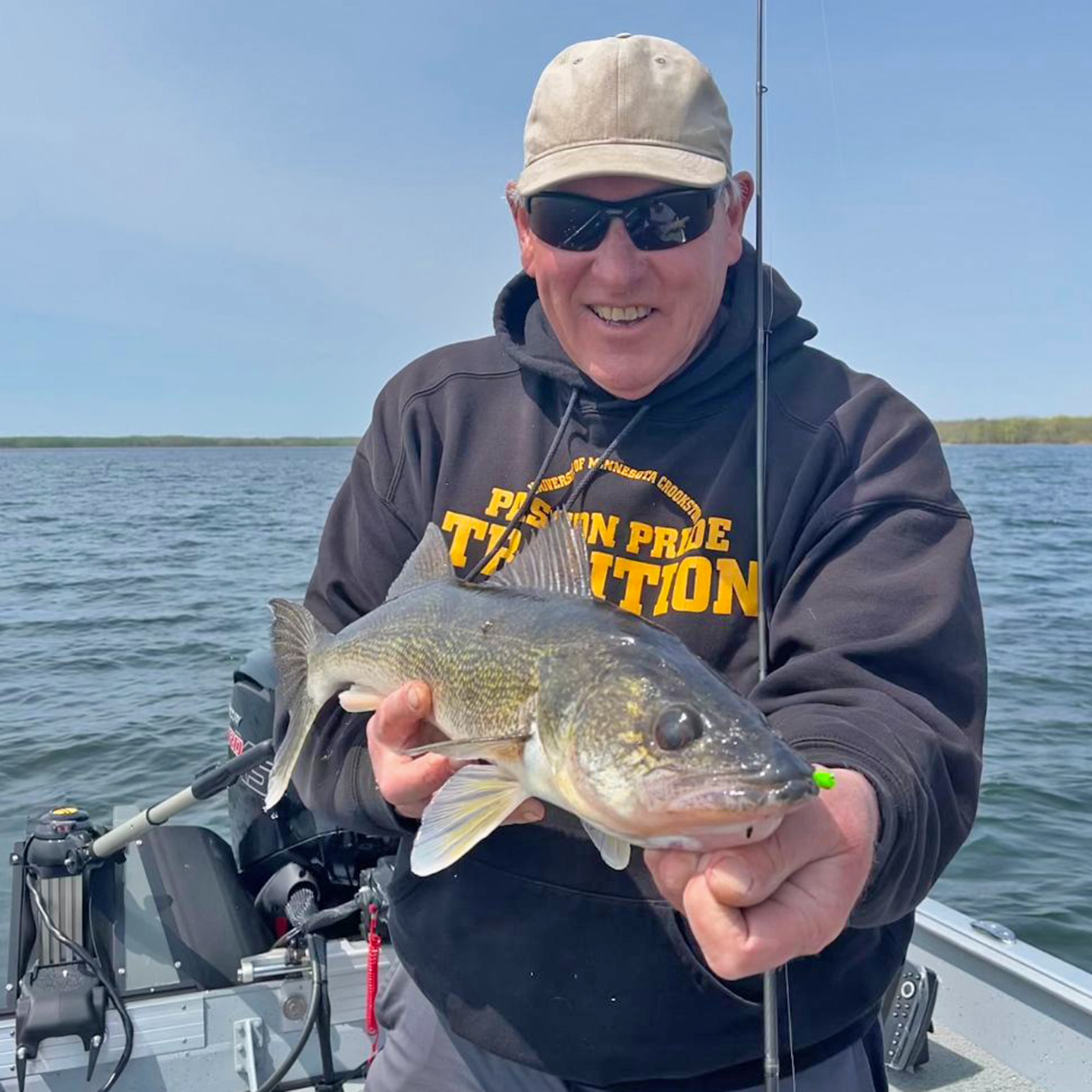 Yesterday’s crew, Phil, Joyce and Kelly already enjoyed a spectacular day at Red Lake Wednesday, and a fabulous fish dinner at Florio’s afterward. So, on Thursday, there was no point in making another long drive. We decided to fish on Winnie, hopefully to cap off the rest of our walleye limits and then maybe find some perch; the walleyes were easier than the perch.
Yesterday’s crew, Phil, Joyce and Kelly already enjoyed a spectacular day at Red Lake Wednesday, and a fabulous fish dinner at Florio’s afterward. So, on Thursday, there was no point in making another long drive. We decided to fish on Winnie, hopefully to cap off the rest of our walleye limits and then maybe find some perch; the walleyes were easier than the perch.
We entered the lake at the Plughat Point landing, and found high, but not flood stage water. Traffic was slower there than I expected, and launching was a smooth operation. The water temperature in the Dam Bay was cool, 54-55 degrees and unusually clean, free of weeds and debris. NOAA was predicting a stiff northwest wind, but when we arrived, the surface was calm. Taking advantage of smooth conditions, I drove straight over to the north shore, in the Bowens Flats neighborhood.
Early in the trip, boats were loosely lined up along the breakline into deep water and it was easy to stake out our own territory. We located small and scattered packs of walleyes holding along the break in 17 to 19 feet of water. We used ¼ ounce jigs tipped with minnows and moved slowly, .5 to .6 MPH was ideal for giving the jigs a light hop-drop-hop-drop action. Walleyes, when we found them did strike, but there were gaps between the small schools. There were a lot of pike on the breakline too and at times, we caught more of them than we did walleyes.
Traffic built through the morning, and eventually become congested. I needed more space to operate, so we started exploring fresh territory. Following the same pattern, we were able to locate other small packs of fish, also holding in the same 17-to-19-foot depth range. Occasionally, walleyes were spotted at 20 feet, but that seemed to be the barrier.
The wind didn’t start blowing as early as we’d expected, but sometime around 3:30 PM, whitecaps started appearing and after that, the bite was tricky. I expect that when the breezes are calm, this fishing pattern will hold up for a while. If the wind keeps blowing, I think I’ll need to figure out some shallower locations. For me, that will all be new territory, so I can’t speculate about where those areas will be. But we’ll figure out where the better schools of fish are located.
Today’s destination is up in the air, but if we do wind up on Winnie, I’ll try to turn a few theories into reality. Whatever we learn, you’ll be the first to know. ![]() — Jeff Sundin 218-245-9858 or EMAIL
— Jeff Sundin 218-245-9858 or EMAIL
 Cutfoot Sioux, Lake Winnie Fishing Report May 17, 2023
Cutfoot Sioux, Lake Winnie Fishing Report May 17, 2023
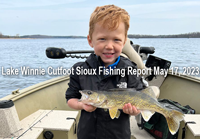 "Lake Winnie and Cutfoot Sioux did not disappoint walleye anglers hoping that the action would be great for the 2023 fishing opener. The weather was fabulous, there was a nice chop on the water and the walleyes were snapping. It’s fair to say that on opening day, there were more folks catching fish, even limits, than those who did not.
"Lake Winnie and Cutfoot Sioux did not disappoint walleye anglers hoping that the action would be great for the 2023 fishing opener. The weather was fabulous, there was a nice chop on the water and the walleyes were snapping. It’s fair to say that on opening day, there were more folks catching fish, even limits, than those who did not.
On Sunday, and each day since, the climate has been warm, bright, and calm. The water temperature is now in the 55-to-57-degree range and the water is clear. Walleyes continue to bite, but have been located spread out over the flats, along the shallow sides of steepest breaklines.
Most fish are not on the steep edges, but rather on top of the flat areas that lead toward them. Key depths on calm days have ranged from ..." Read >> Lake Winnie Cutfoot Sioux Fishing Report May 17, 2023
 Jeff Sundin May 3, 2023 "Hey, Get Your Hands Off My Eggs!"
Jeff Sundin May 3, 2023 "Hey, Get Your Hands Off My Eggs!"
![]() ON May 2, 2023 Kurt Stevenson wrote; “Hey Jeff, I was reading your article (May 1, 2023) and noticed the part about stripping walleye eggs at Cutfoot. If you ask me, they should leave the fish there alone instead of taking all the spawn out of the lake. I’ll bet Winnibigosh has a lot better track record in the years when there’s nobody stealing all our walleye eggs. You should into that.” Kurt Stevenson
ON May 2, 2023 Kurt Stevenson wrote; “Hey Jeff, I was reading your article (May 1, 2023) and noticed the part about stripping walleye eggs at Cutfoot. If you ask me, they should leave the fish there alone instead of taking all the spawn out of the lake. I’ll bet Winnibigosh has a lot better track record in the years when there’s nobody stealing all our walleye eggs. You should into that.” Kurt Stevenson
 Thank you for the note, Kurt, and for the invitation for me to roll up my sleeves and get to work on this update in response. As it happens, your comments are representative of other comments that I, and some of the resort owners on Winnie receive from folks every spring. Over the years, those of us who attend annual meetings with DNR Fisheries Staff have heard the simple answer repeated often, but to my knowledge, nobody has done a deeper dive into the subject. So, let’s start with the simple answer first, then I’ll share what I learned in my meeting at the Grand Rapids DNR office last Monday.
Thank you for the note, Kurt, and for the invitation for me to roll up my sleeves and get to work on this update in response. As it happens, your comments are representative of other comments that I, and some of the resort owners on Winnie receive from folks every spring. Over the years, those of us who attend annual meetings with DNR Fisheries Staff have heard the simple answer repeated often, but to my knowledge, nobody has done a deeper dive into the subject. So, let’s start with the simple answer first, then I’ll share what I learned in my meeting at the Grand Rapids DNR office last Monday.
The simple answer is that the DNR Egg Take at Little Cutfoot does not reduce the amount of fry that hatch on their own and swim back into the lakes. Walleyes migrating through Little Cutfoot on the annual spawning run into the First River do complete the task of spawning, but the fertilized eggs seldom mature and hatch. On its own, the First River spawning run almost never produces significant contributions to the overall walleye population in Winnie, Cutfoot and connected waters.
How is that possible, why don’t all those eggs hatch and produce offspring? Evolution is the problem; sticky, oxygen robbing sediment now covers what might have been, at one time, prime spawning habitat. But nowadays, most of the fertilized eggs that fall to the bottom get covered with muck, which coats the eggs and then suffocates them before they can reach maturity. When fertilized eggs are taken to the Grand Rapids hatchery, about 10% of the hatched fry is returned to Winnie and Cutfoot. Survivability of the hatched fry is significantly higher than it would have been if the fish had simply dropped their eggs in the mud and taken their chances.
 To get a better handle on how the process works, I scheduled a meeting with Dave Weitzel, Grand Rapids Area Fisheries Supervisor. Coincidentally, Gerry Albert, the now retired DNR Large Lake Specialist who worked on Winnie for over two decades happened to walk in, so we invited him to be part of the interview and he agreed.
To get a better handle on how the process works, I scheduled a meeting with Dave Weitzel, Grand Rapids Area Fisheries Supervisor. Coincidentally, Gerry Albert, the now retired DNR Large Lake Specialist who worked on Winnie for over two decades happened to walk in, so we invited him to be part of the interview and he agreed.
“Were there ever any formal studies proving the theory about the poor success rates of spawning at the First River?” I asked.
Yes, Dan Olson, former Grand Rapids DNR Fisheries Biologist studied the issue. Olson sampled fertilized walleye eggs and aged them using a process that studies cell division within the egg. The oldest, or most advanced eggs, survived for 4 days; most of them did not last that long. What Olson discovered then was that the sediment that coated the outer shell of the egg was preventing oxygen from reaching the cells within them.
By now, another DNR Fisheries Biologist walked into the office. Weitzel introduced me Dan Schermerhorn, the incoming Large Lake Specialist who pick up the studies of all things Winnibigoshish. Schermerhorn joined the discussion in time for my next question, “what is the survival rate of wild hatched walleye fry?” I asked.
The consensus among the experts is that on average, survival of walleye fry hatched in the wild is below 2%. Weitzel showed me some charts of statistics for Winnie and Cutfoot, which on average, have survival rates even lower than that; some years well below 1%. The survival rate of fry brought back from the hatchery and released into Winnie and Cutfoot is much higher than that. The rate varies from year to year, but can be double, sometimes even more, than the wild hatched fry.
Kurt, it was your original question, “I’ll bet Winnibigosh has a lot better track record in the years when there’s nobody stealing all our walleye eggs?” that prompted my next question for the panel. “How many alternative spawning sites are there on Winnie and Cutfoot?”
Albert walked us into the back room and pulled out a large map of Winnie and its connected waters. As he unrolled the map, numbered red marking denoted the well-known walleye spawning sites. There were 25 sites marked up on the map, Albert told me that 1 of them was usually a poor spot, and there were a few others thought of as “marginal”. So, let’s call it 20, known alternatives to the Little Cutfoot, First River spawning site. Unclear whether I had permission to share the map, I opted not to reproduce it. But it is real, and it is public information, so if you want to see it yourself, set up an appointment with the Grand Rapids Fisheries office.
The Olson study on First River survival rates is also public information, but it is buried deep in old files. If you want to see that study, it would be wise to send a request and allow plenty of extra time for DNR Staff to review it in house.
For me, the upshot of the meeting with Weitzel, Albert and Schermerhorn was that even if the egg take at Little Cutfoot was deleted forever, Lake Winnie walleye anglers would likely never notice any difference. Which leads us back to your comment Kurt, “I’ll bet Winnibigosh has a lot better track record in the years when there’s nobody stealing all our walleye eggs. You should into that.”
Statistics from last year’s testing on Winnie and Cutfoot show that the 2020-year class of walleye was poor. Ironically, covid concerns resulted in no walleye egg taken by the DNR at Little Cutfoot that spring. To your point, if the theory that walleye would be better off without the hatchery operation is true, then 2020 “should have been” good, but it wasn’t.
Whether any lake produces a strong year class of walleye is way more complex than that. Survival rates are much more important to the lake than the success of the spring spawning runs. Think of it this way, the lake can never produce a strong year class unless the young fish survive their first season. No matter how many walleye fry hatch during spring, they are completely dependent on suitable weather and habitat through their first summer. Still oversimplified, but one good rule of thumb is this; Poor 1st year survival = Poor year class. • Good 1st year survival = Good year class.
Finally, if you’re like me and like to fish on a variety of lakes, you might be more dependent on the Grand Rapids Hatchery than you think. Many of my favorite walleye lakes have fish that were provided by the hatched fry from that operation. Even if you never fish any other lake than Winnie, you still benefit from those fish. Why? Because if somebody is fishing on another lake, then they are not bothering you when you’re fishing your favorite spots on Winnie.
Whether or not the Little Cutfoot egg take will happen this season is up in the air. I chatted with Dave Weitzel yesterday and he told me that the decision will be made later today. Either way, my suggestion is that we should embrace the operation. All things considered, walleye anglers everywhere in the Grand Rapids region benefit from fish produced there. ![]() — Jeff Sundin 218-245-9858 or EMAIL
— Jeff Sundin 218-245-9858 or EMAIL
 Cutfoot Sioux, Lake Winnie 2023 Walleye Fishing Season Outlook May 2, 2023
Cutfoot Sioux, Lake Winnie 2023 Walleye Fishing Season Outlook May 2, 2023
 "Walleye anglers, curious about the progress of the ice breaking up on Lake Winnie may have had a few anxious moments this spring. But, compared to last year’s “ice-out cliff hanger”, this is going to be a walk in the park. Today’s images of Cutfoot and Winnibigoshish compared to those we viewed around the same time in 2022 indicate that we’re 4 to 5 days ahead of where we were last spring. Admittedly, this still constitutes a later than typical ice-out, but at least we have a little bit of wiggle room to work with. In other words, the 2023 walleye season is going to happen on schedule, and we’ll be ready!
"Walleye anglers, curious about the progress of the ice breaking up on Lake Winnie may have had a few anxious moments this spring. But, compared to last year’s “ice-out cliff hanger”, this is going to be a walk in the park. Today’s images of Cutfoot and Winnibigoshish compared to those we viewed around the same time in 2022 indicate that we’re 4 to 5 days ahead of where we were last spring. Admittedly, this still constitutes a later than typical ice-out, but at least we have a little bit of wiggle room to work with. In other words, the 2023 walleye season is going to happen on schedule, and we’ll be ready!
This year, we’re anticipating a continuation of the strong angler catch rates we enjoyed in both 2021 and 2022. The 2 back-to-back, “dynamo year classes” of walleyes from 2018 and 2019 will continue to dominate the population. This summer, the size structure of walleyes from both years will be very desirable. Many of the fish will ..." Read >> Cutfoot Sioux, Lake Winnie 2023 Walleye Fishing Season Outlook May 2, 2023
 Bowen Lodge Cutfoot Sioux, Lake Winnie Fishing Report April 24, 2023 "The ice is melting!"
Bowen Lodge Cutfoot Sioux, Lake Winnie Fishing Report April 24, 2023 "The ice is melting!"
 "Despite winter's desperate attempts to hang on, spring is coming to northern Minnesota. We heard a loon yesterday, eagles are soaring and the ice is starting to darken on Lake Winnibigoshish—that means open water is coming soon.
"Despite winter's desperate attempts to hang on, spring is coming to northern Minnesota. We heard a loon yesterday, eagles are soaring and the ice is starting to darken on Lake Winnibigoshish—that means open water is coming soon.
For those who follow Bowen Lodge on Facebook, last week you may have watched Jens and Ashley drill a hole in front of the resort that yielded about 20 inches of ice. That may seem discouraging, but our forecast is promising and we're optimistic that the ice will leave the lake soon.
In the meantime, everyone is working hard to prepare Bowen Lodge for our first guests to arrive on opening weekend. We're thrilled to open our doors for the 2023 season. If you're still hoping to stay with us this summer, we recently had some prime openings in our cabins that are sure to be reserved quickly. We hope you can join us!" Bill, Gail, Jens & Ashley • Call 218-246-8707 • Website